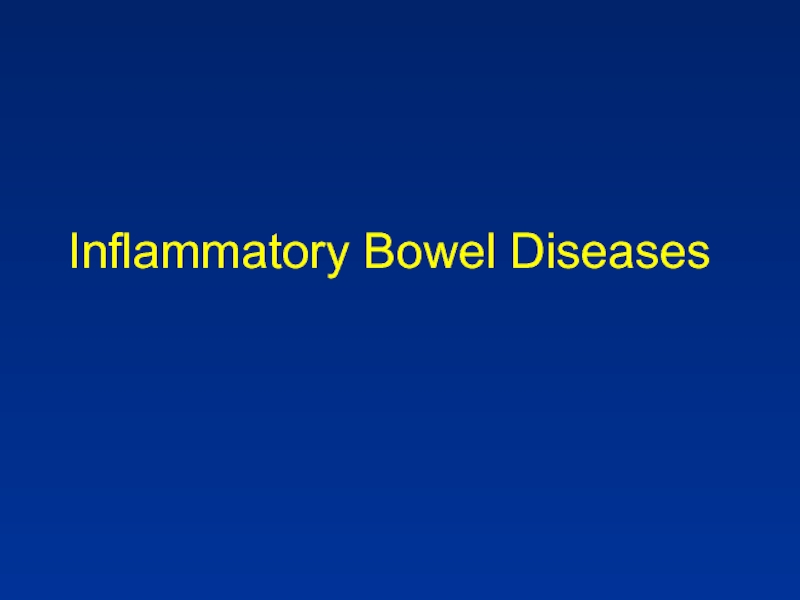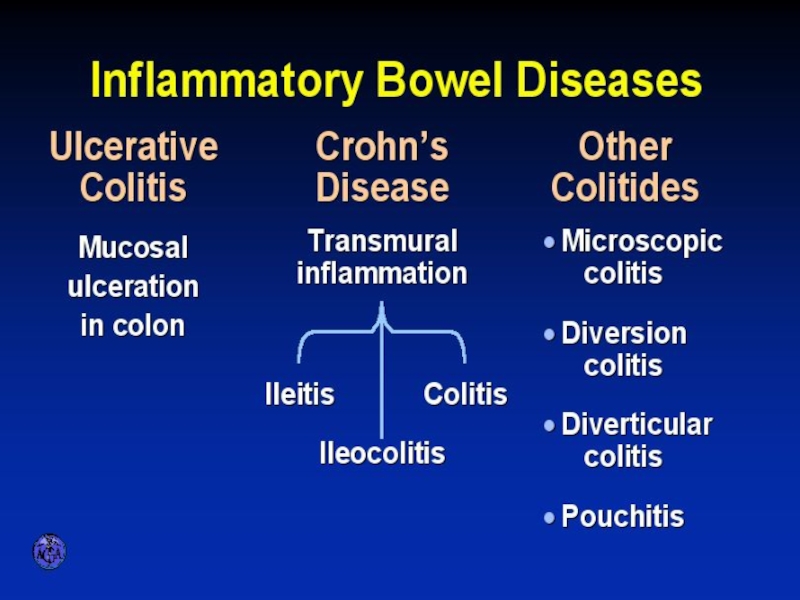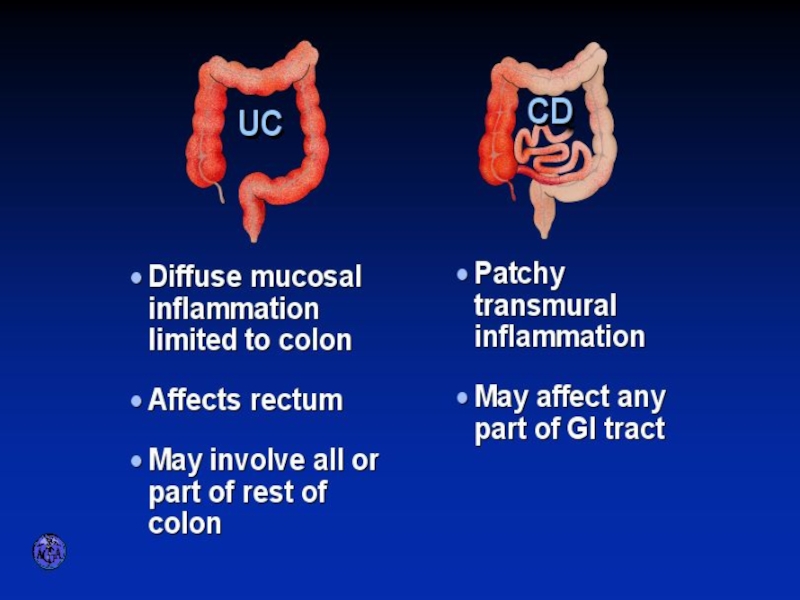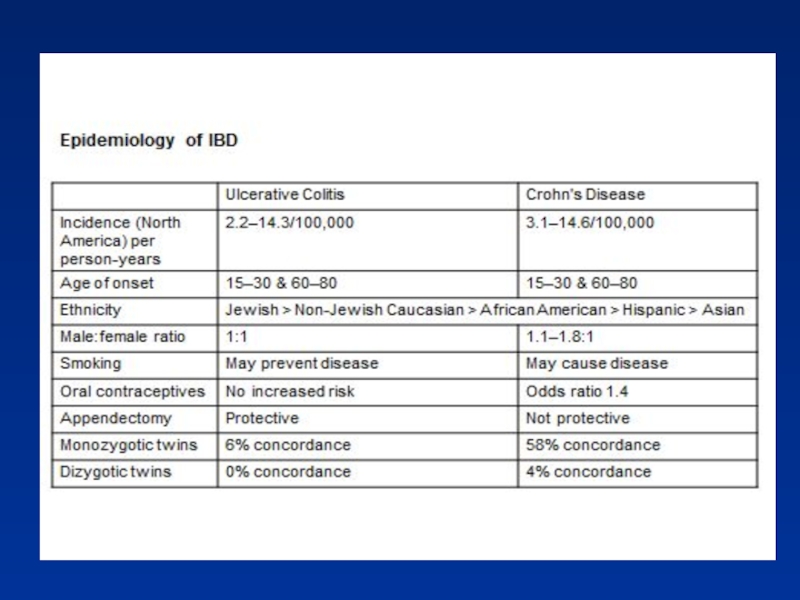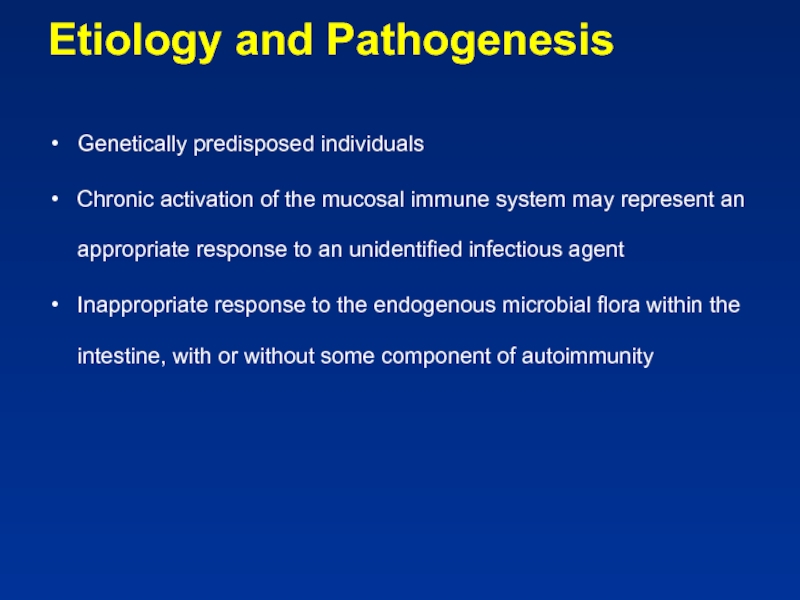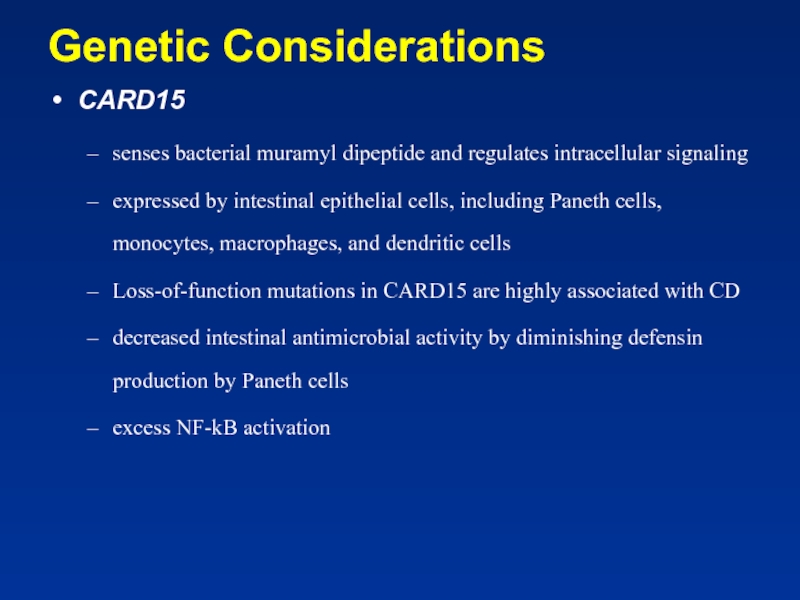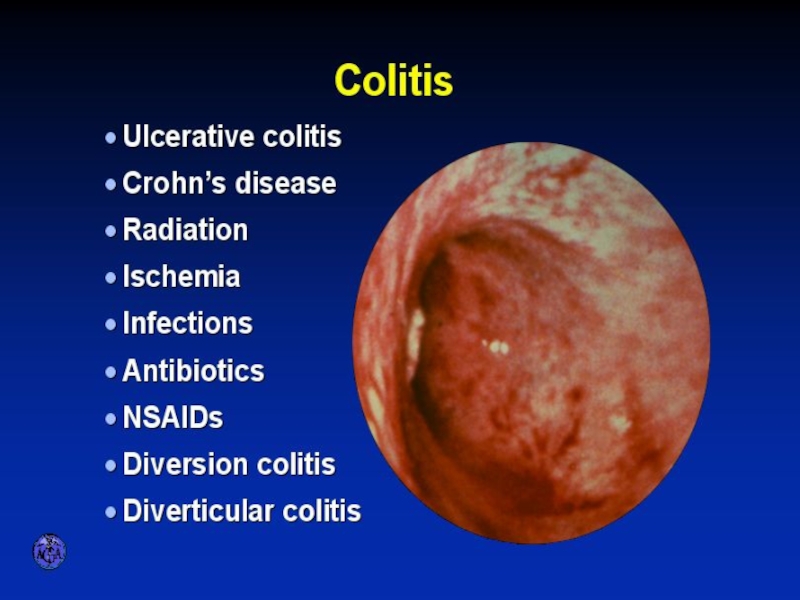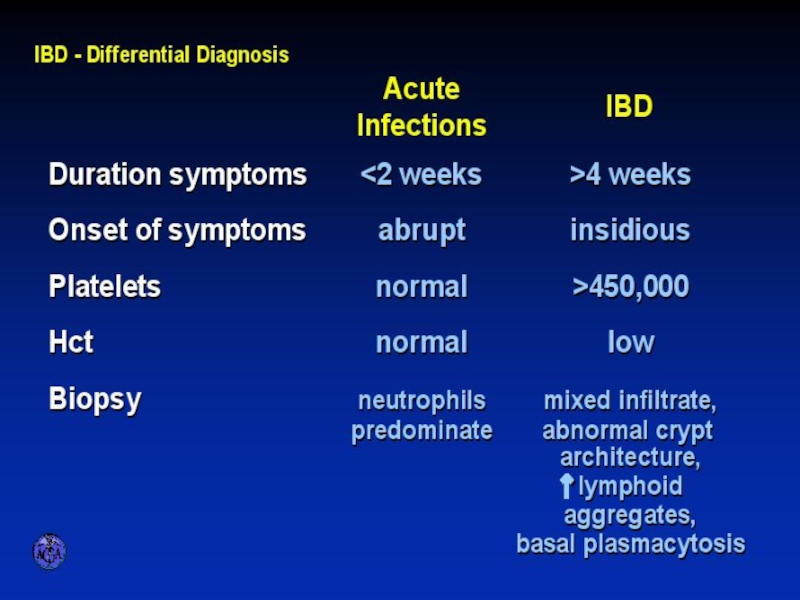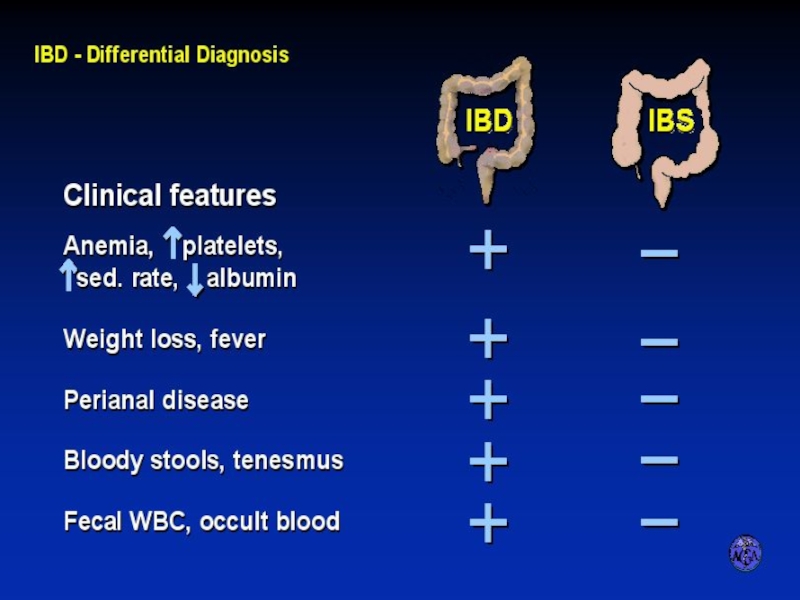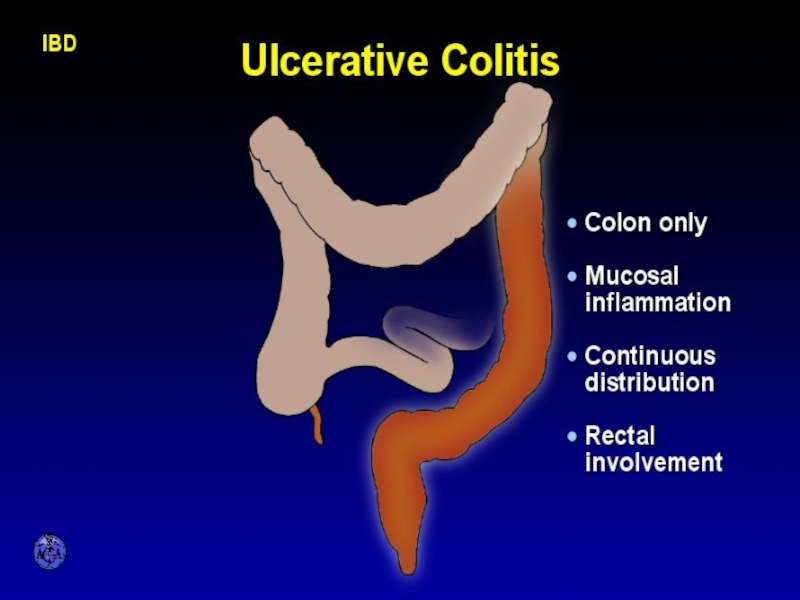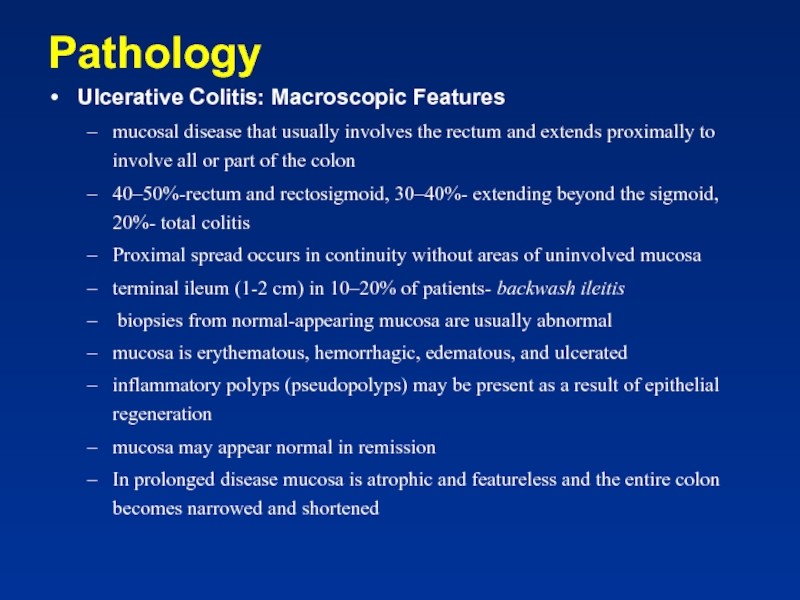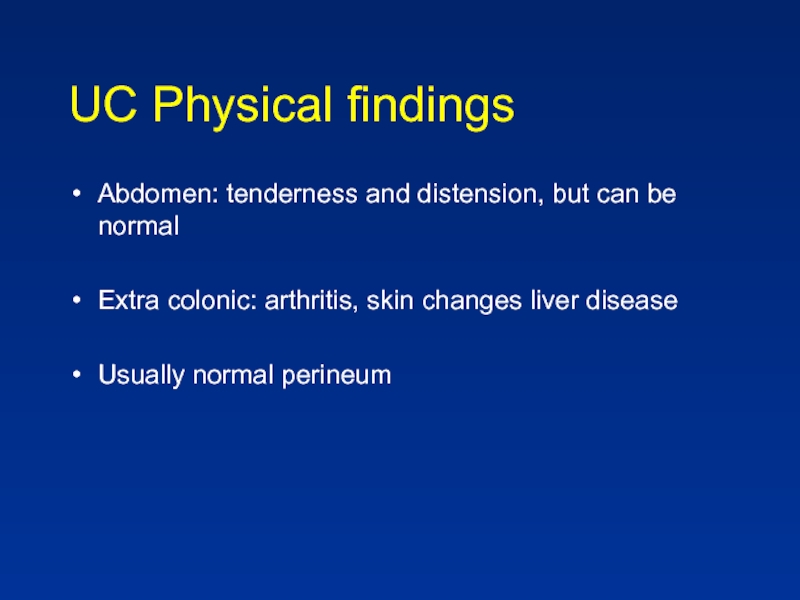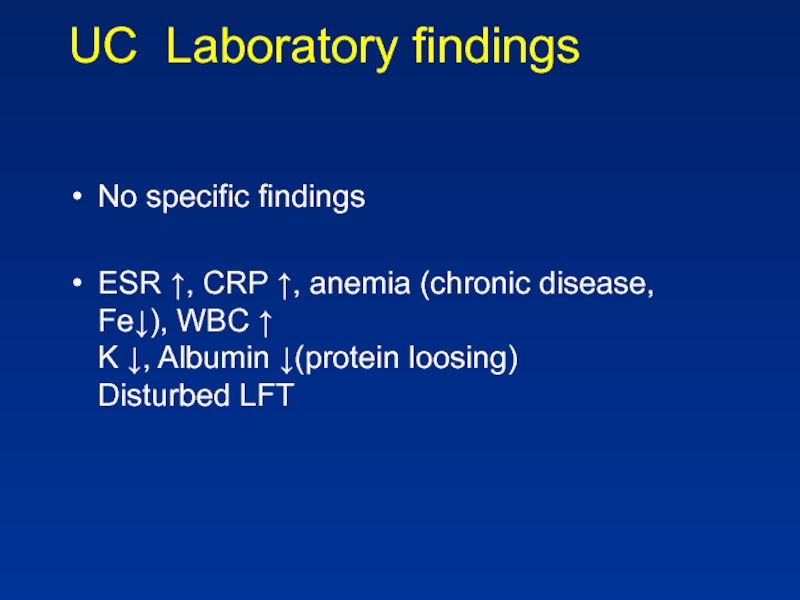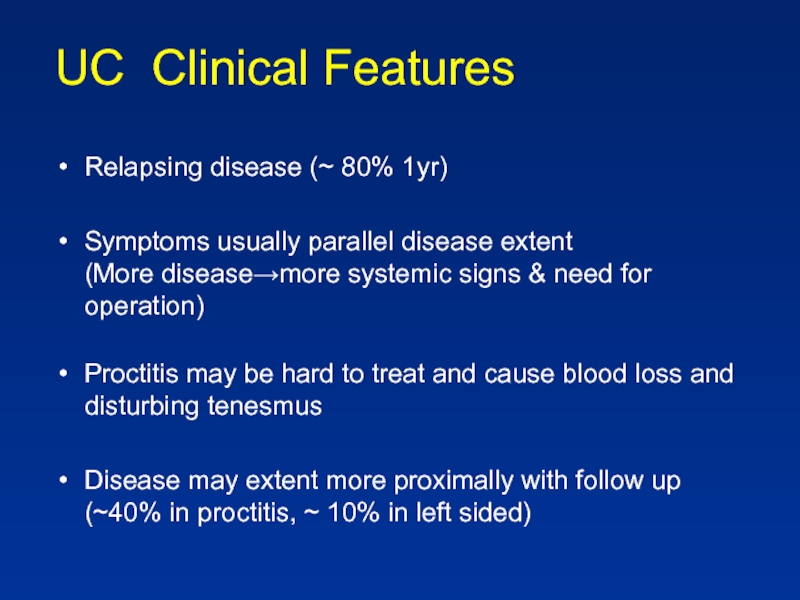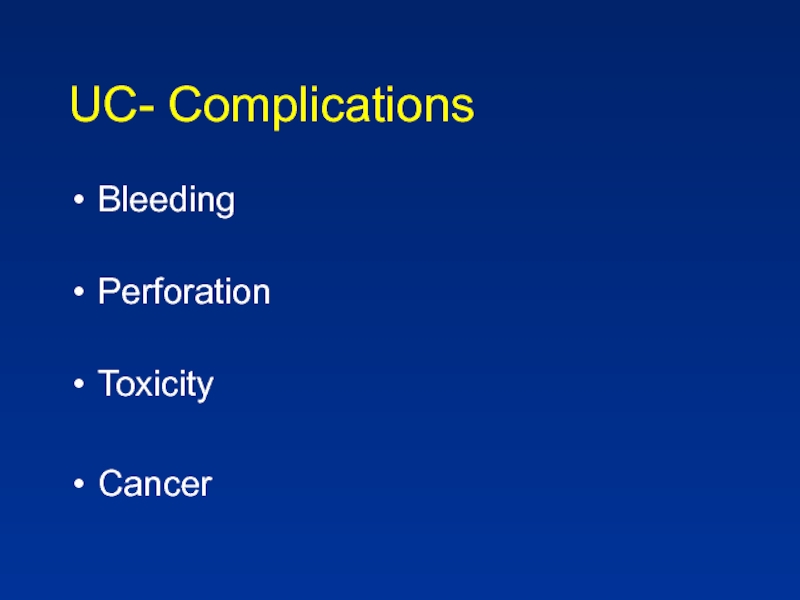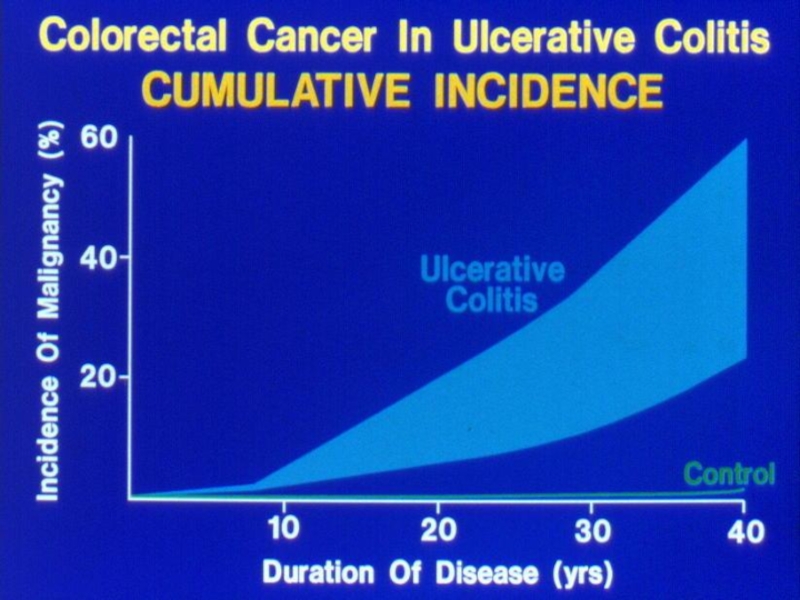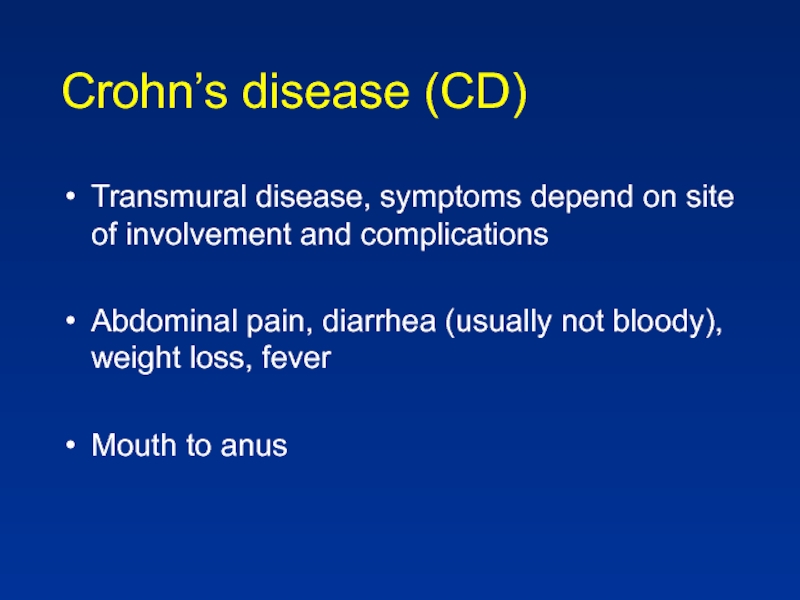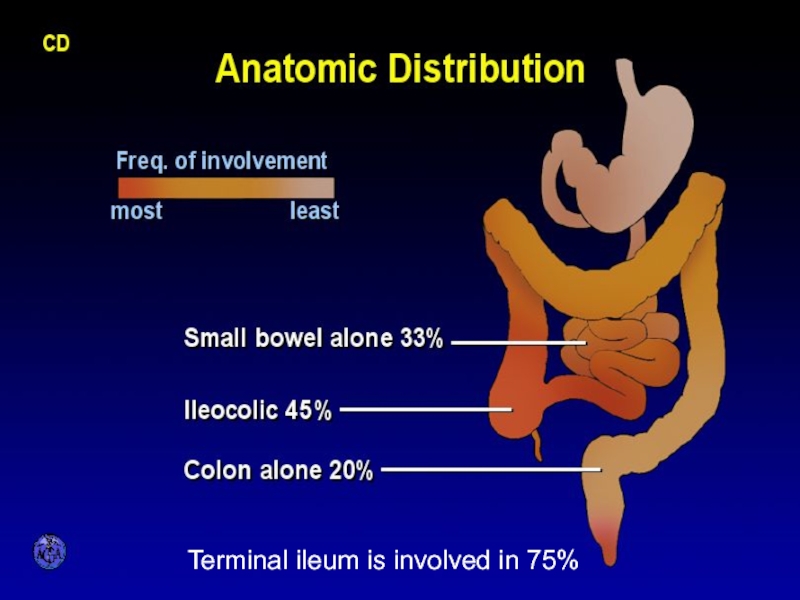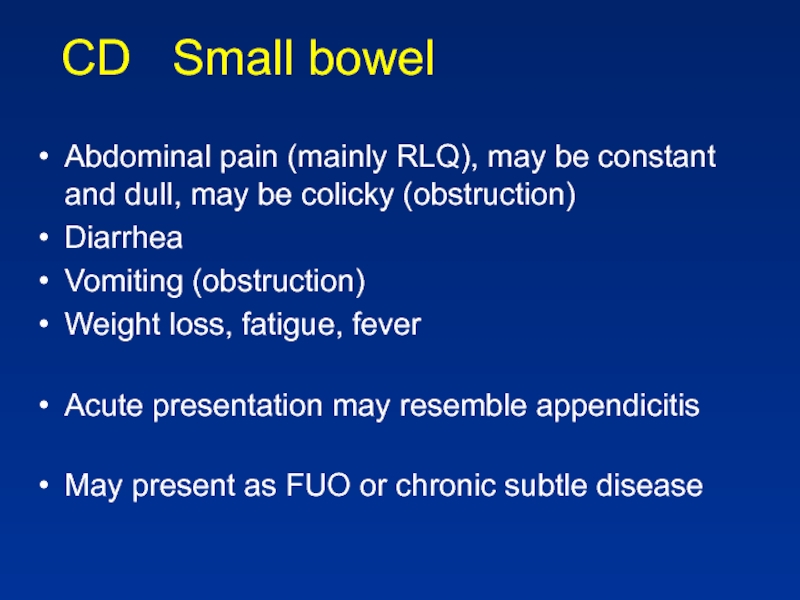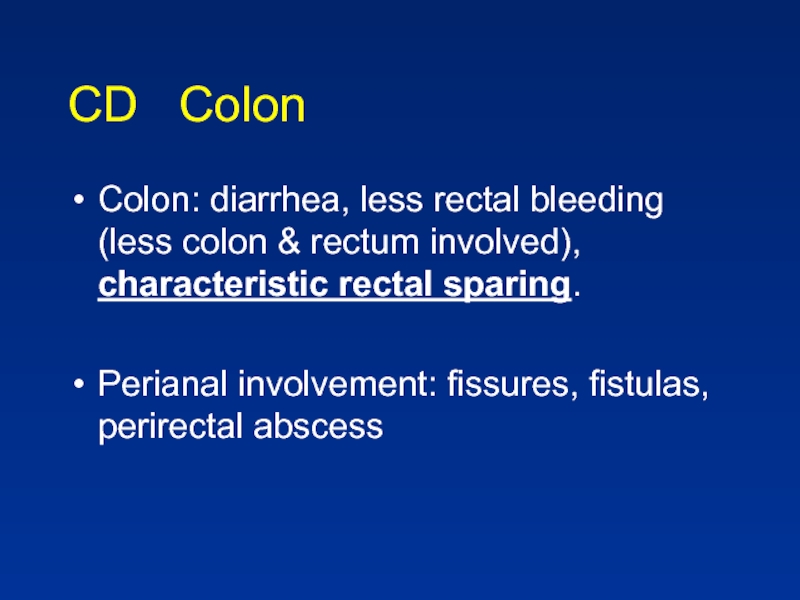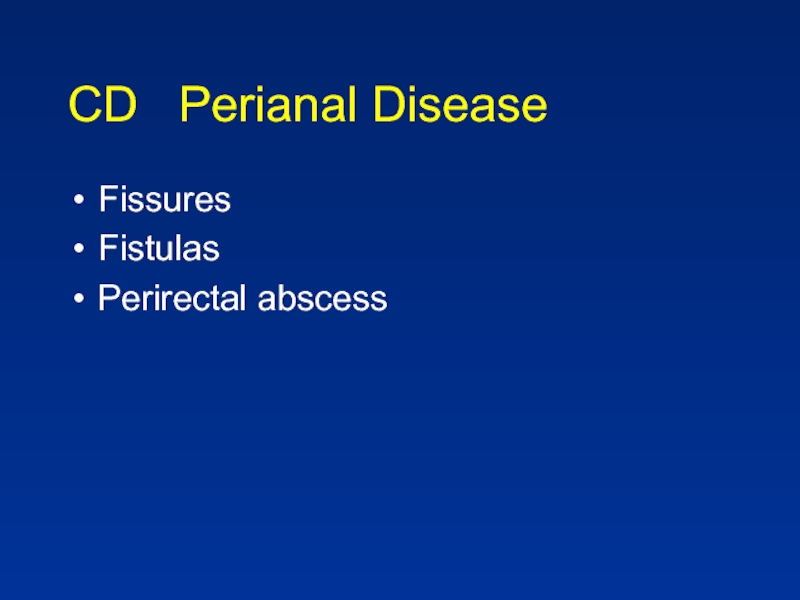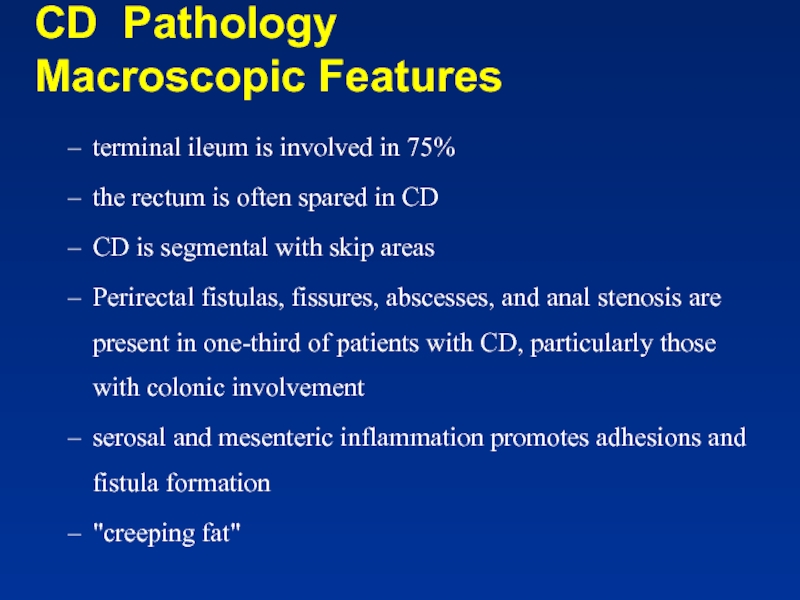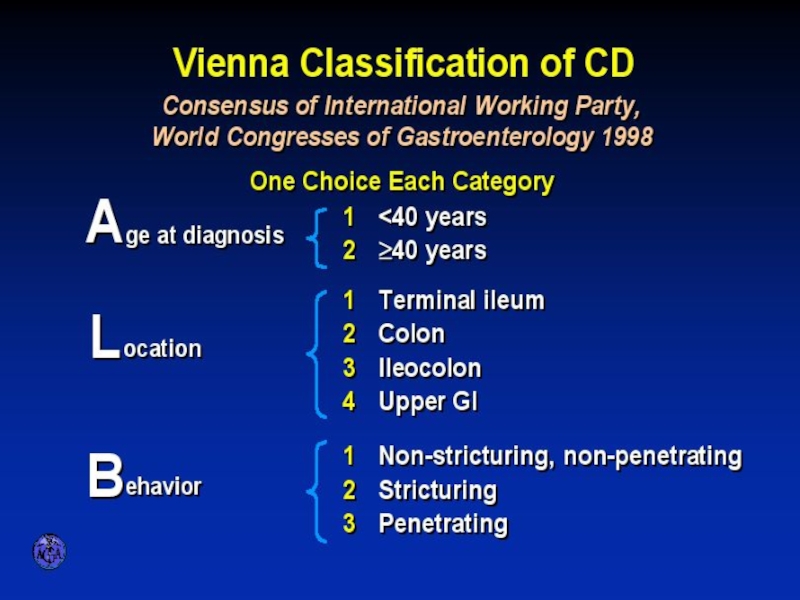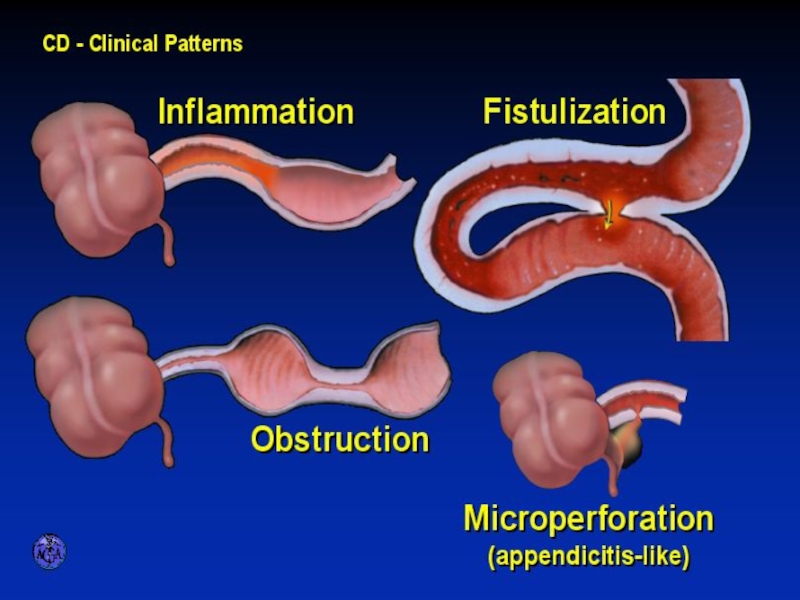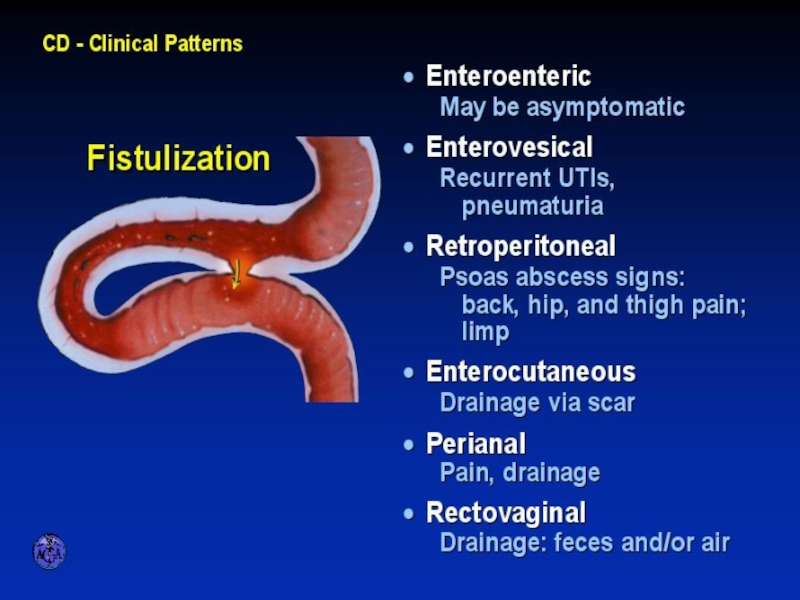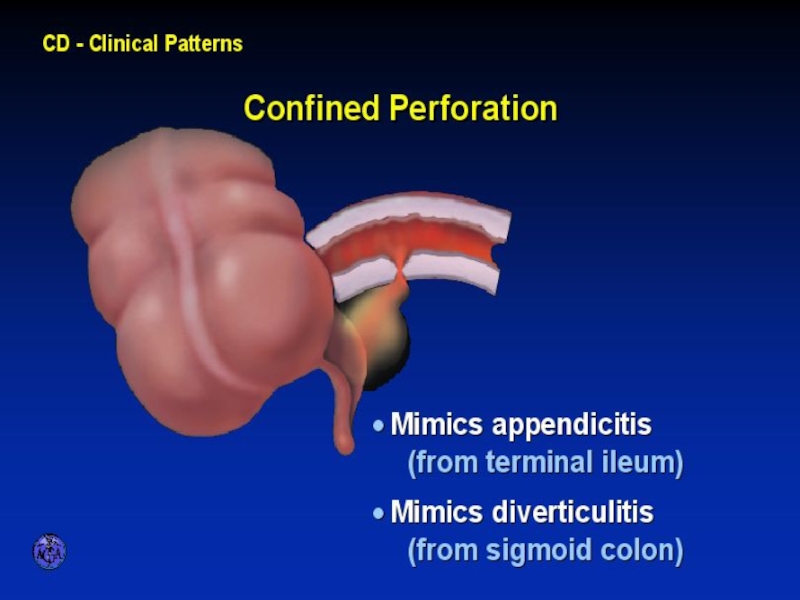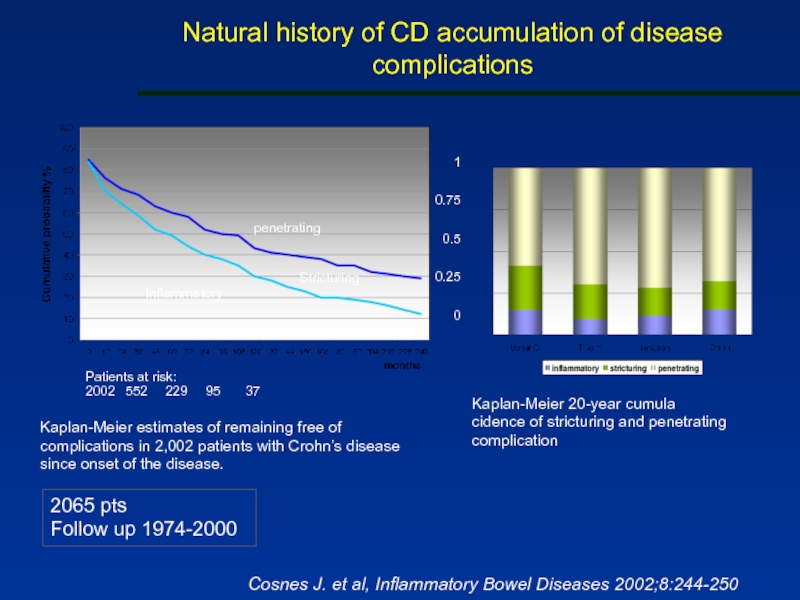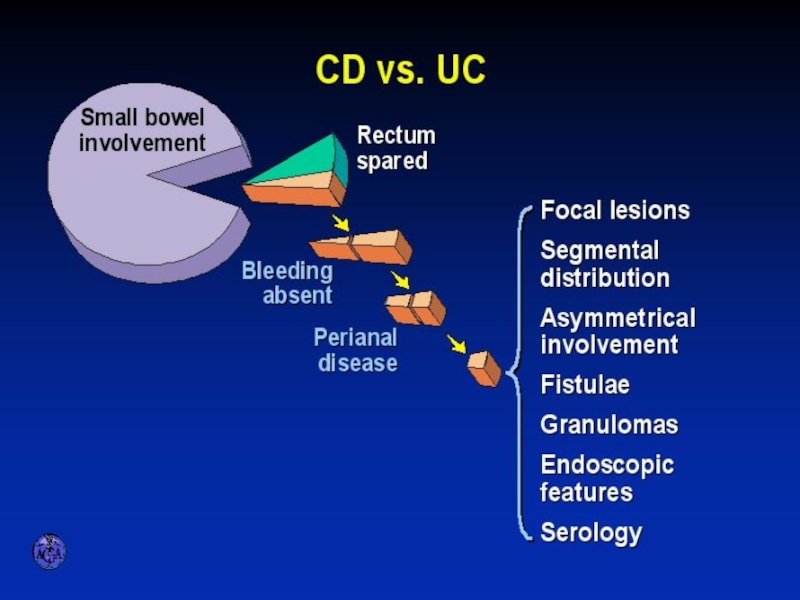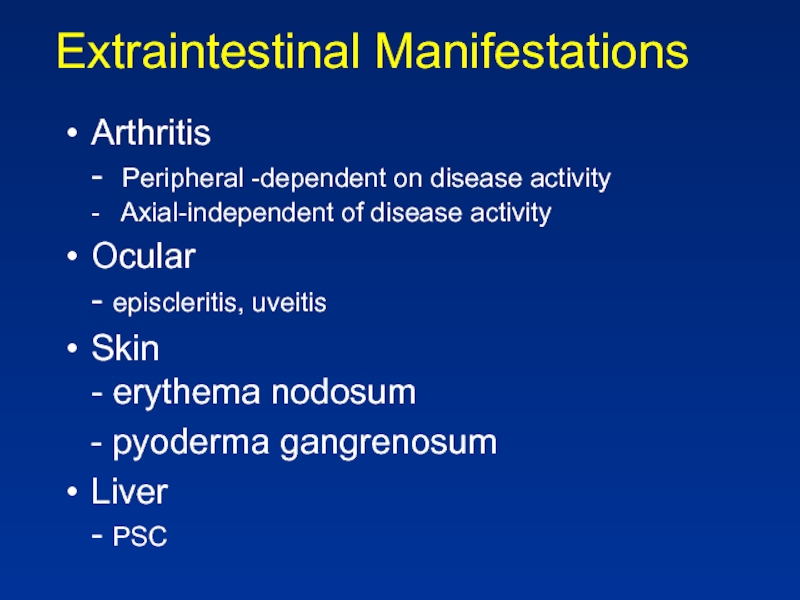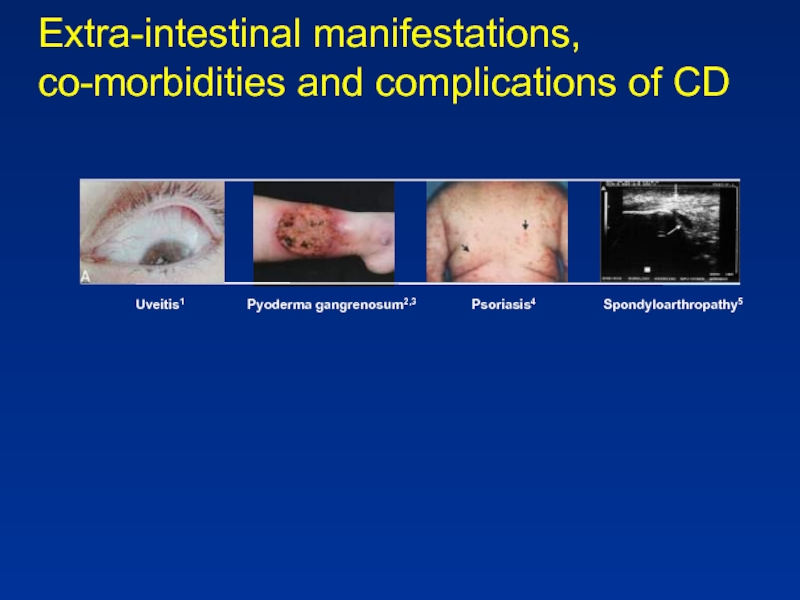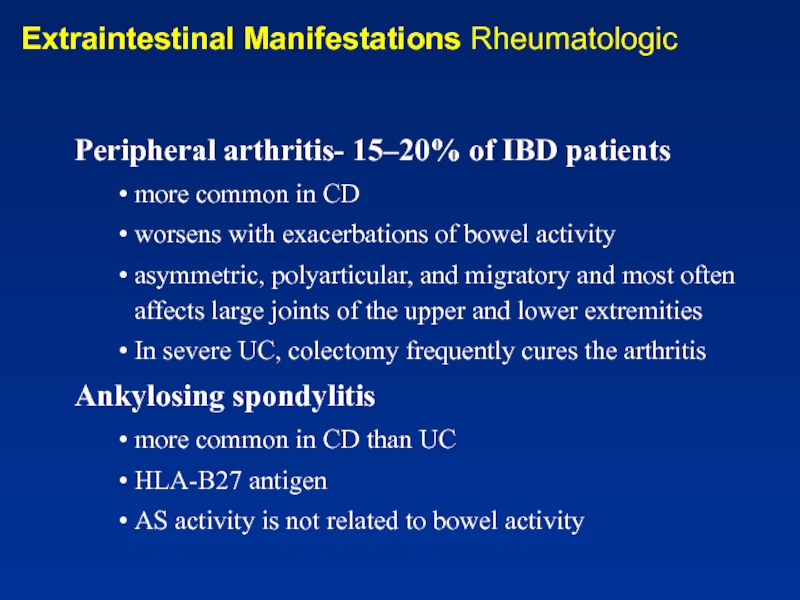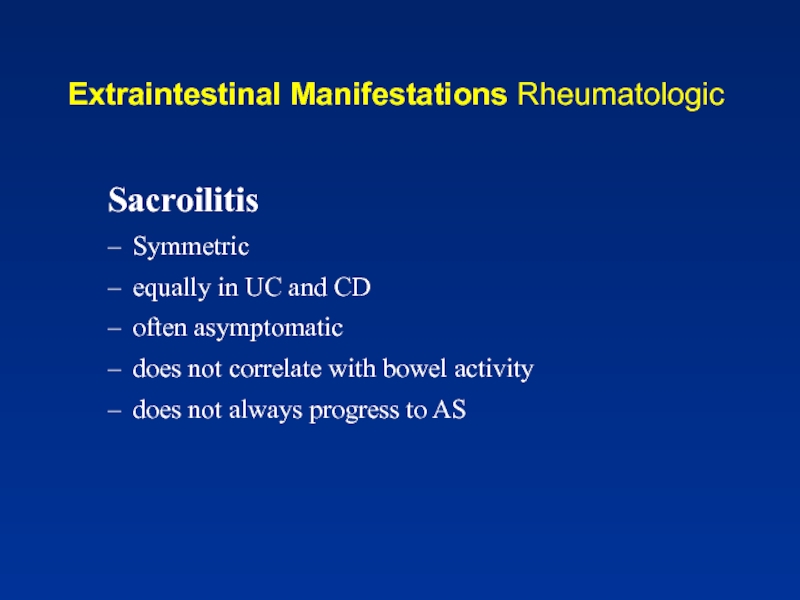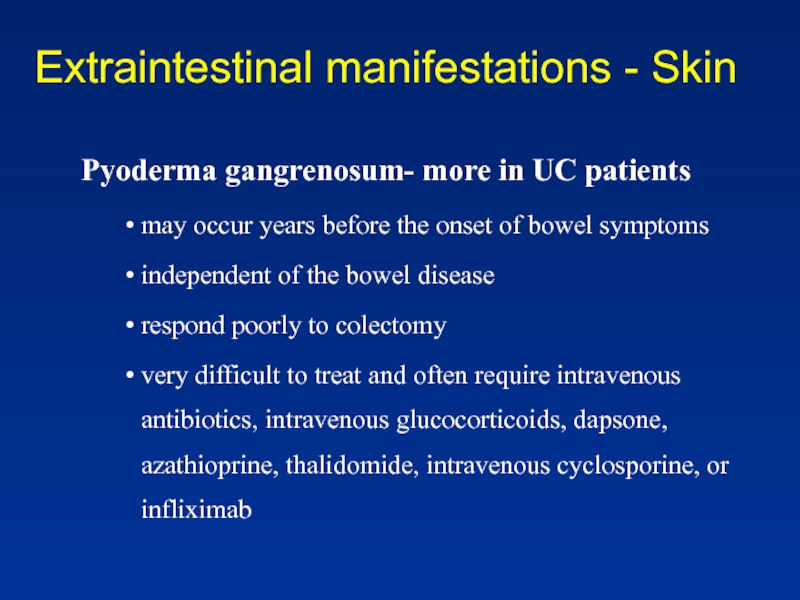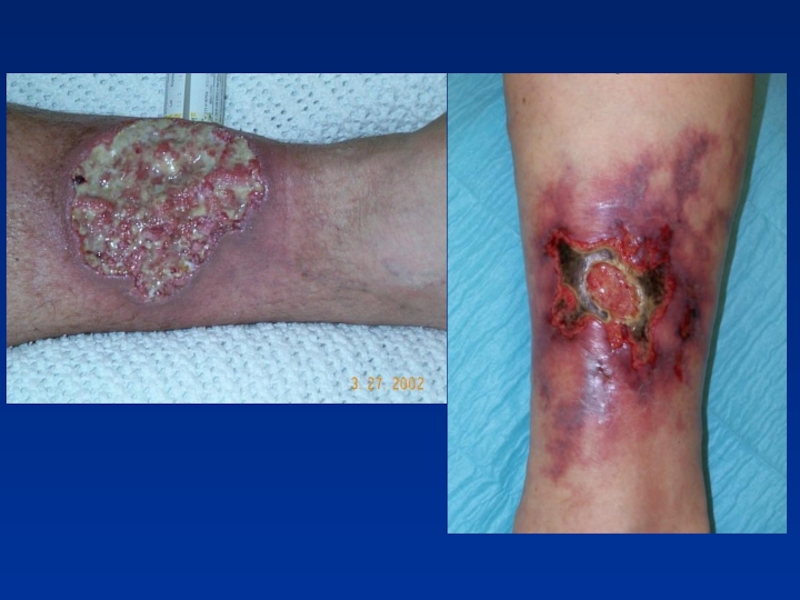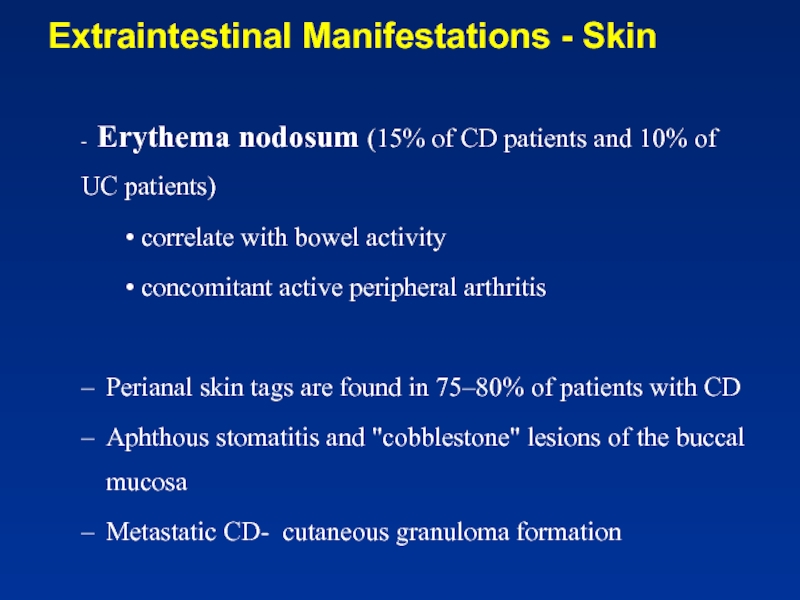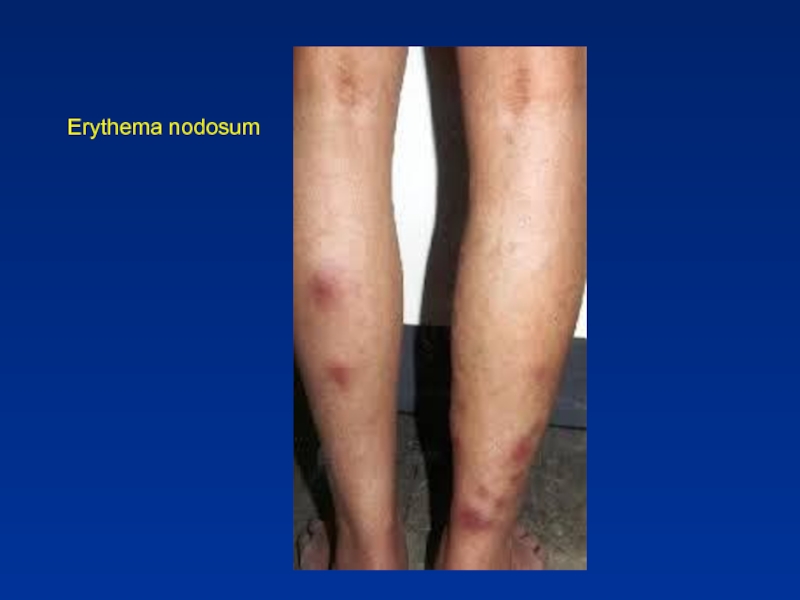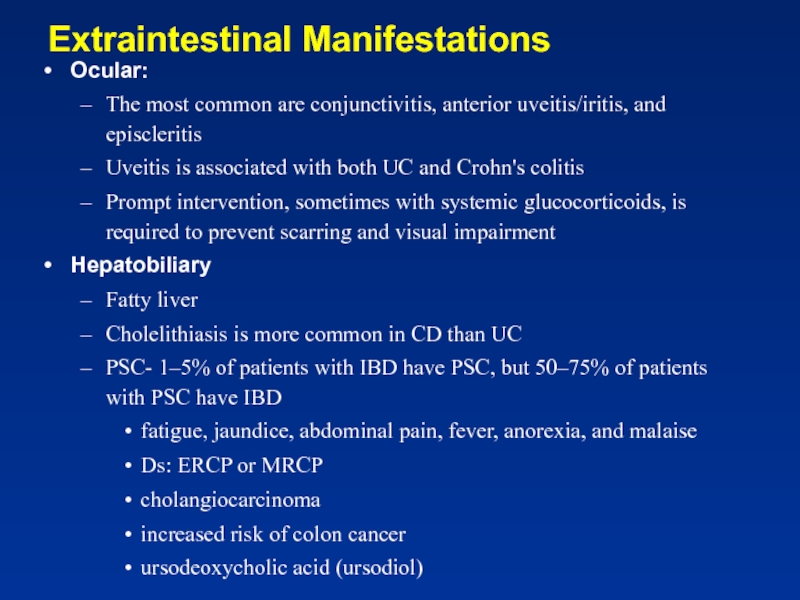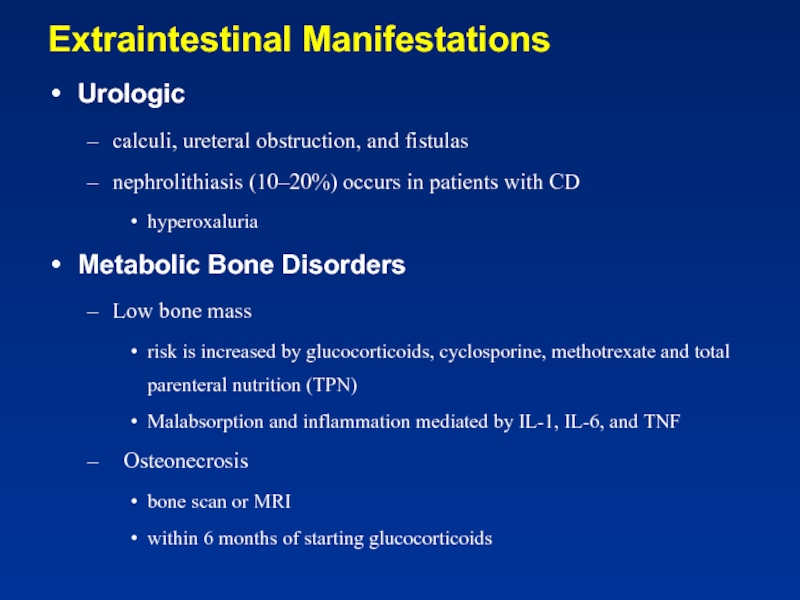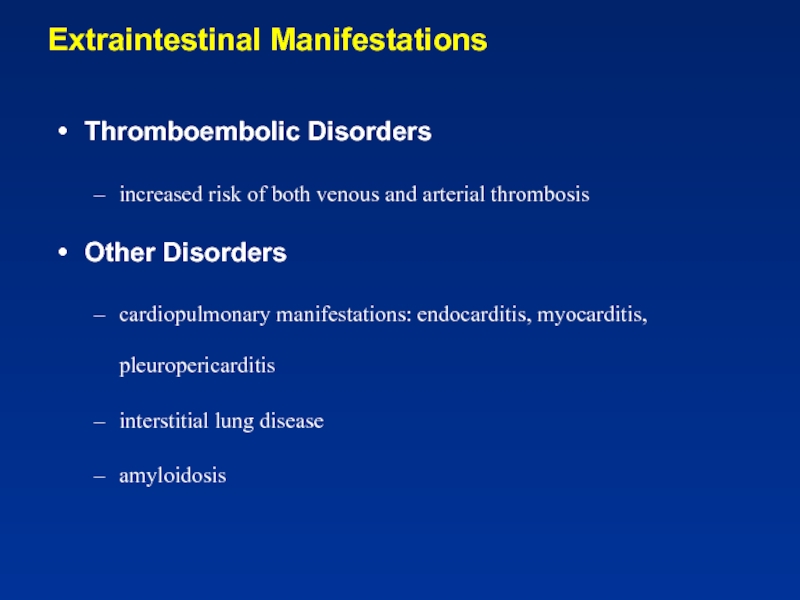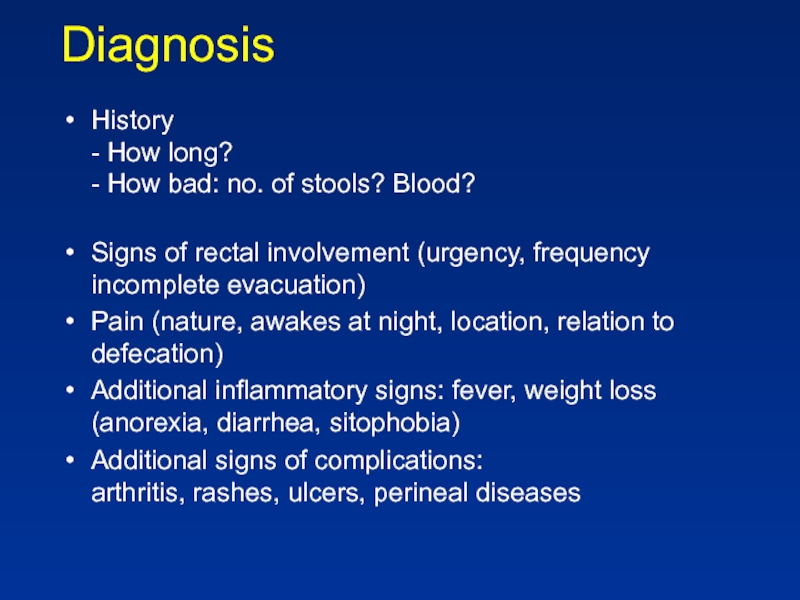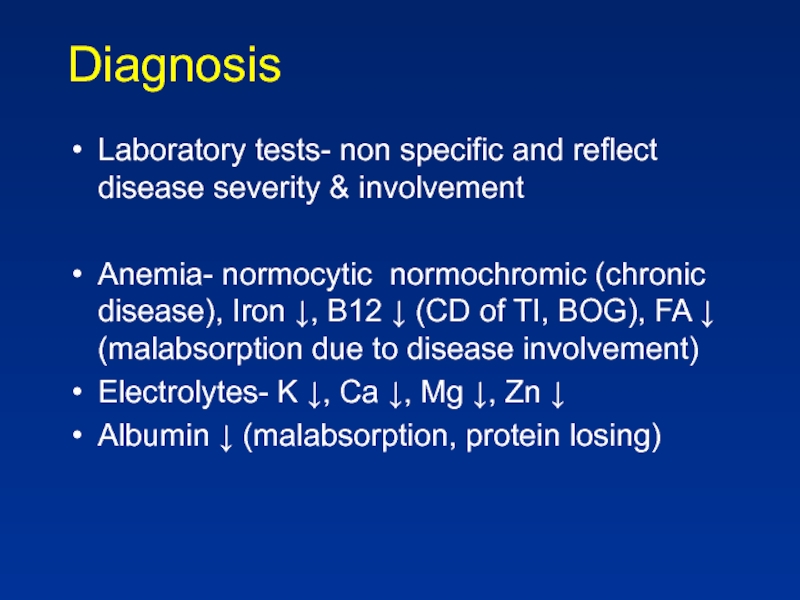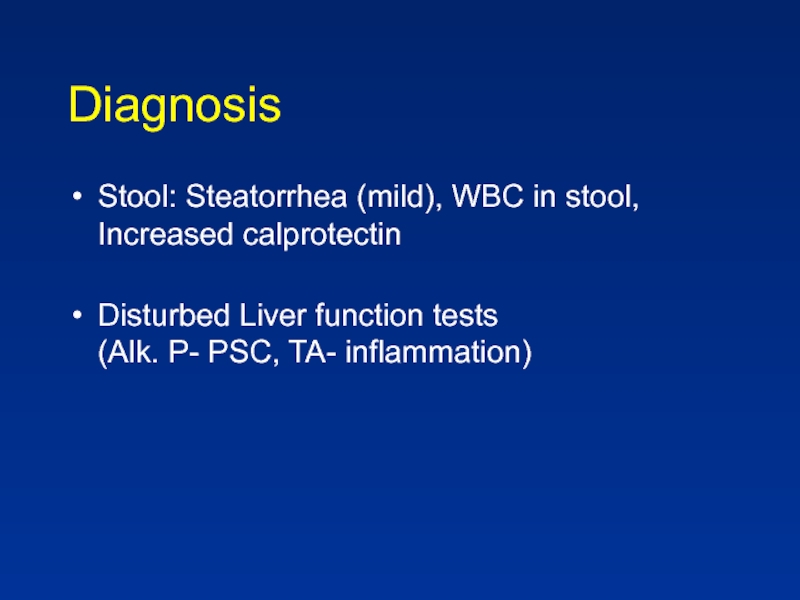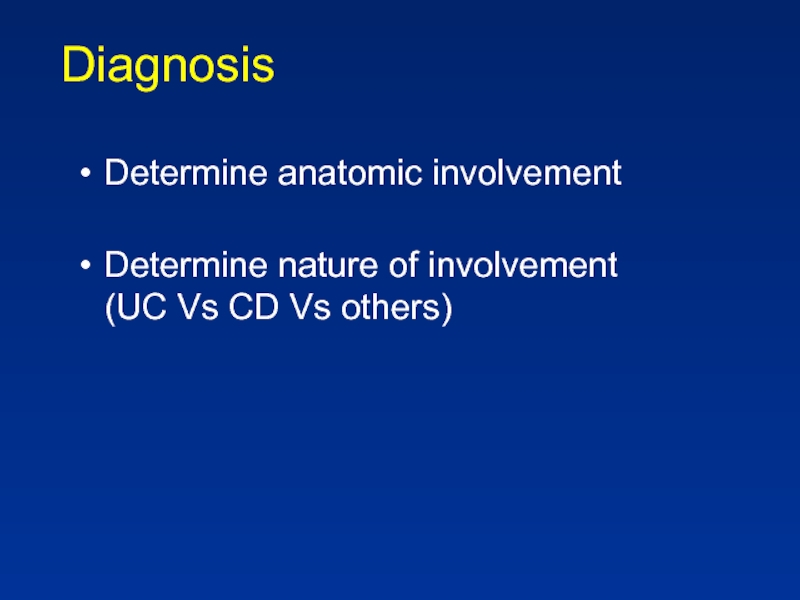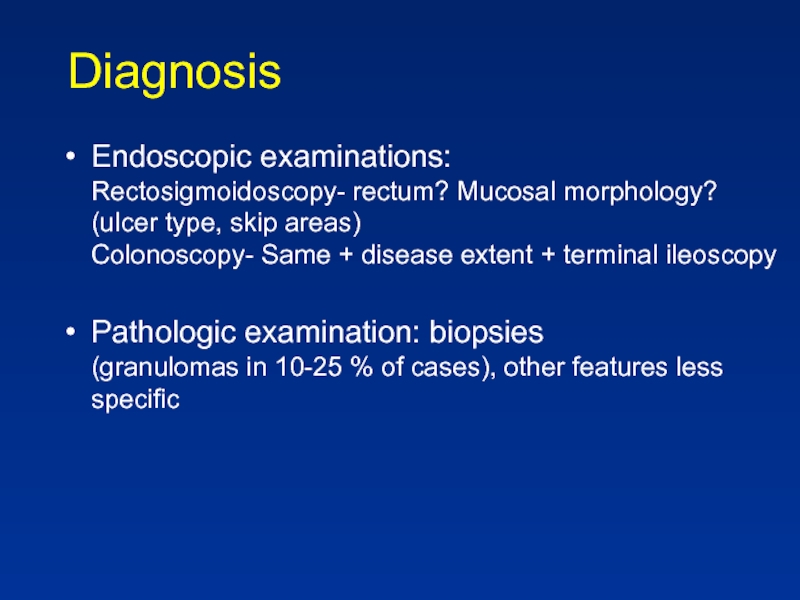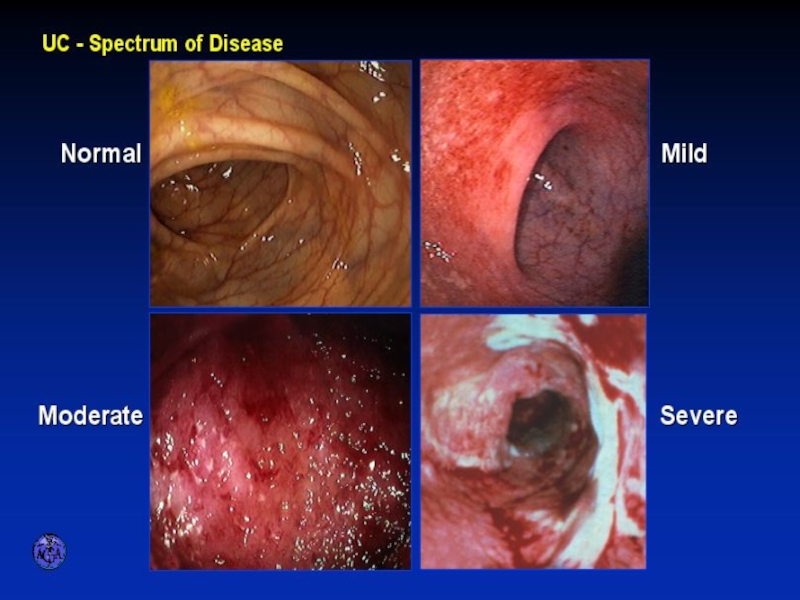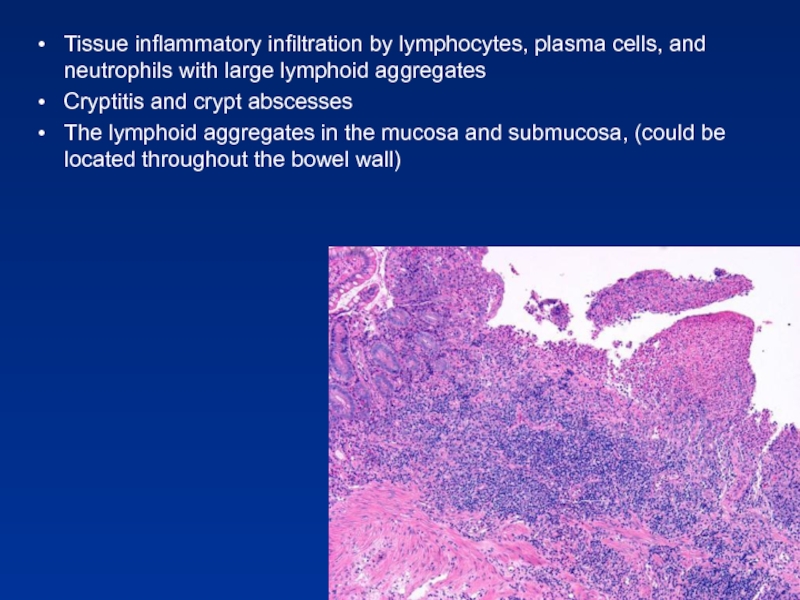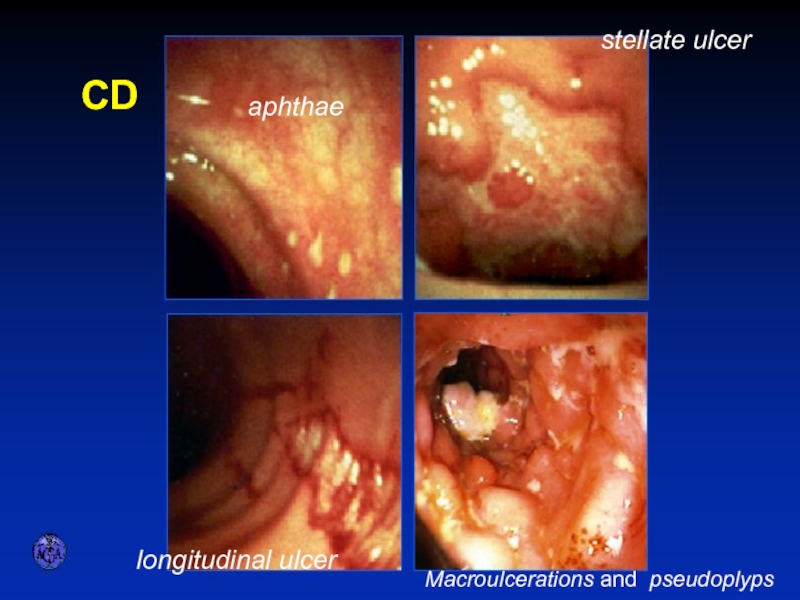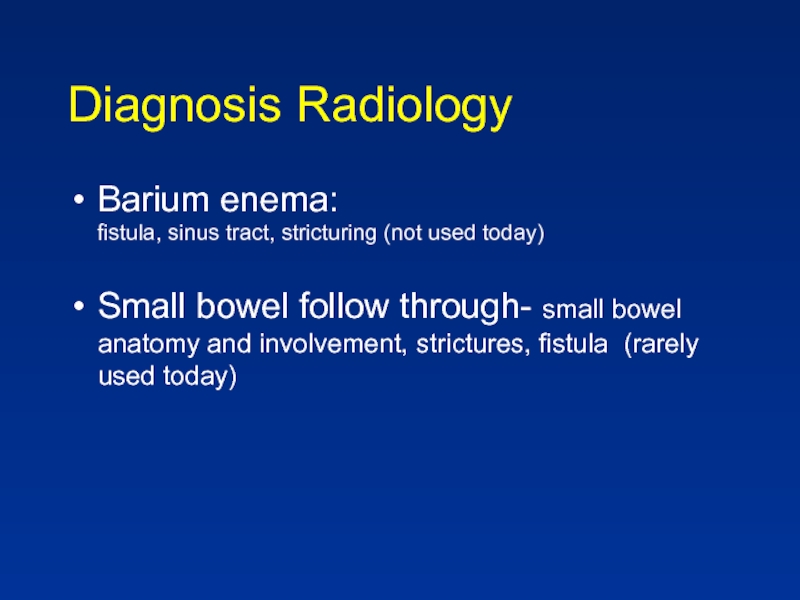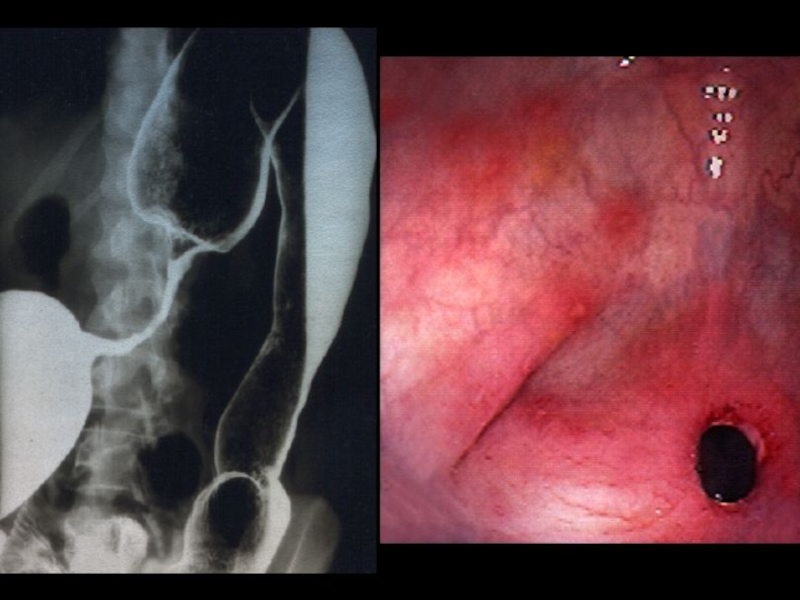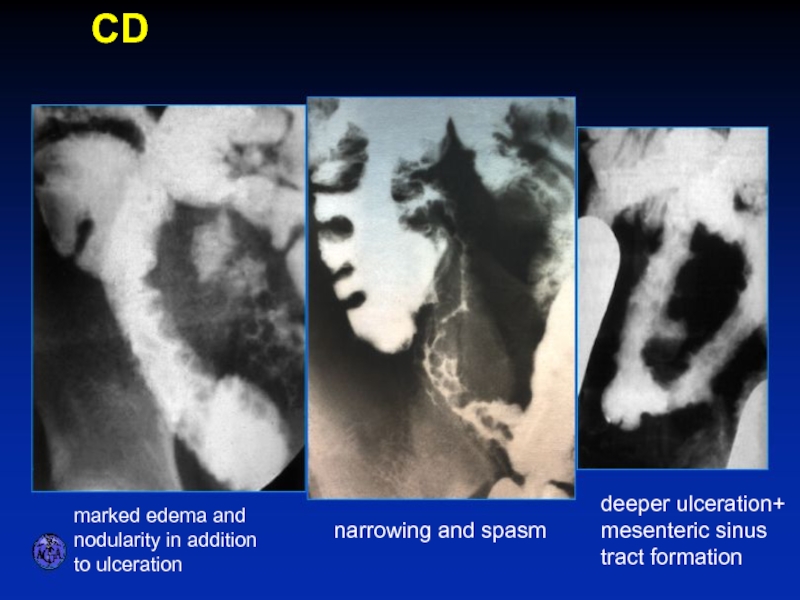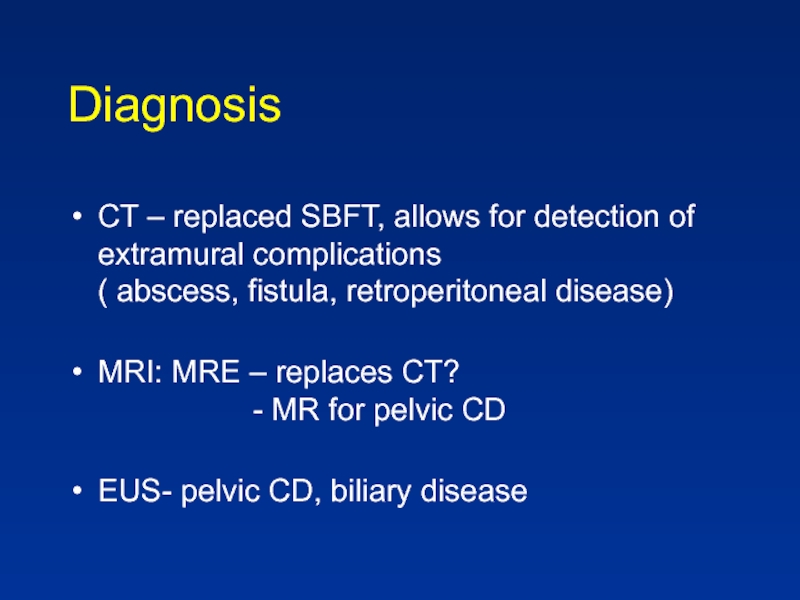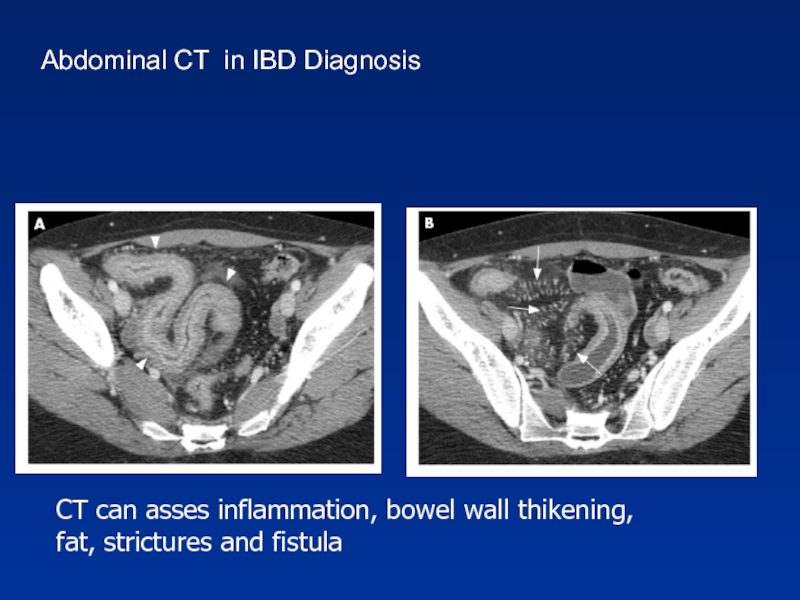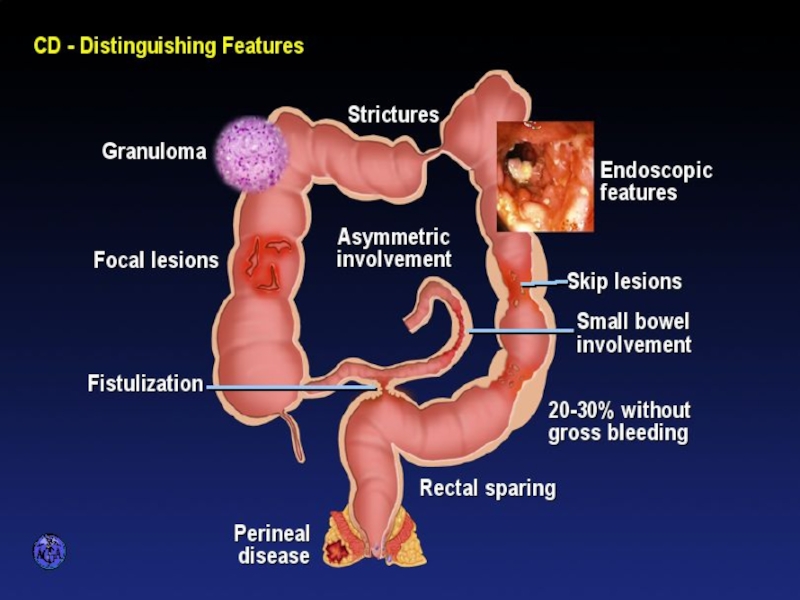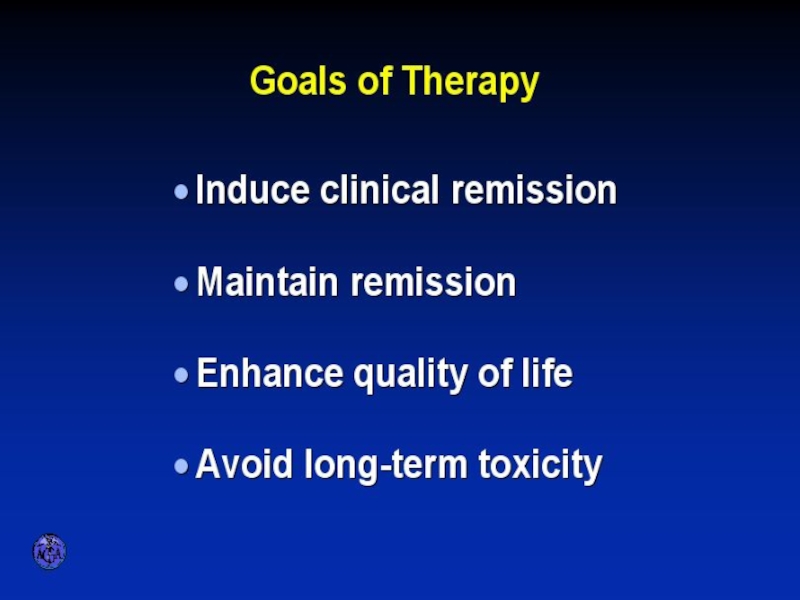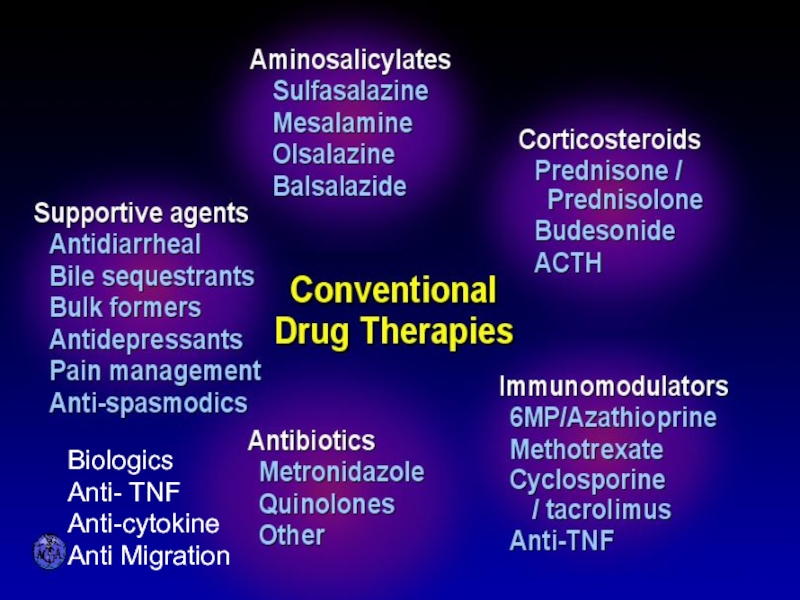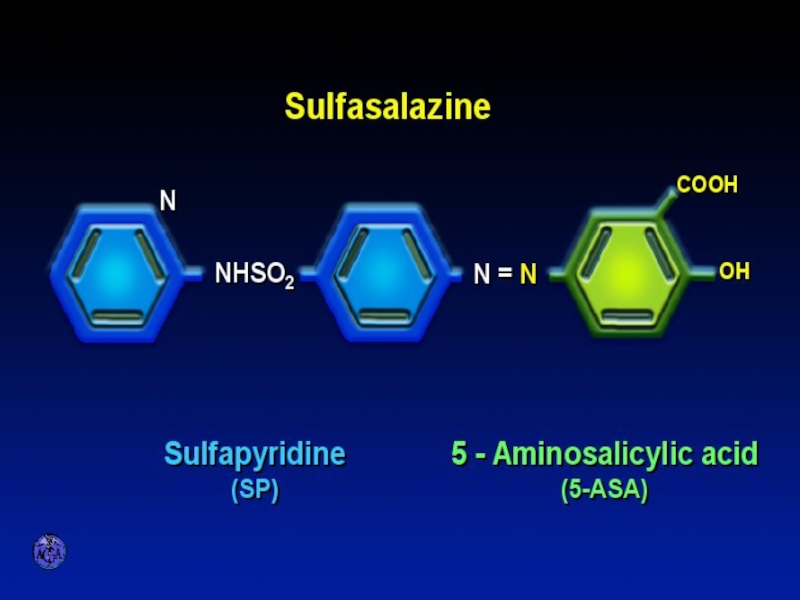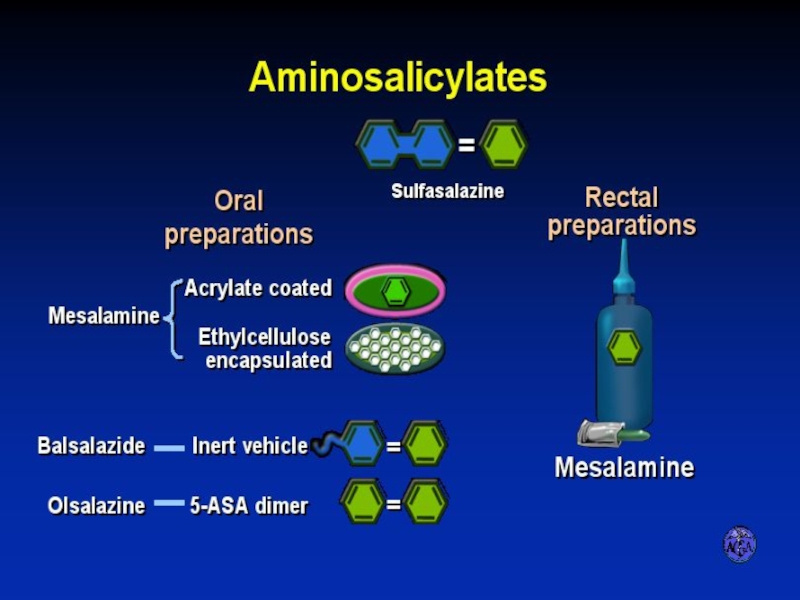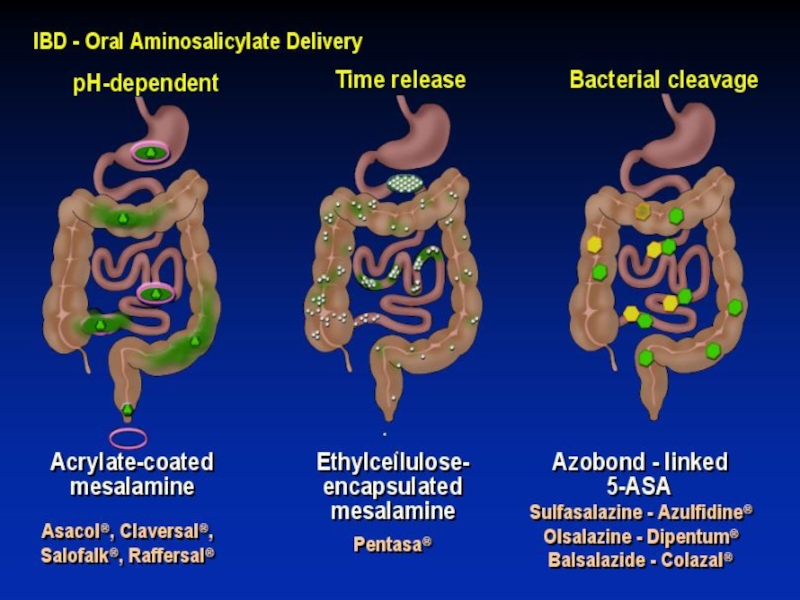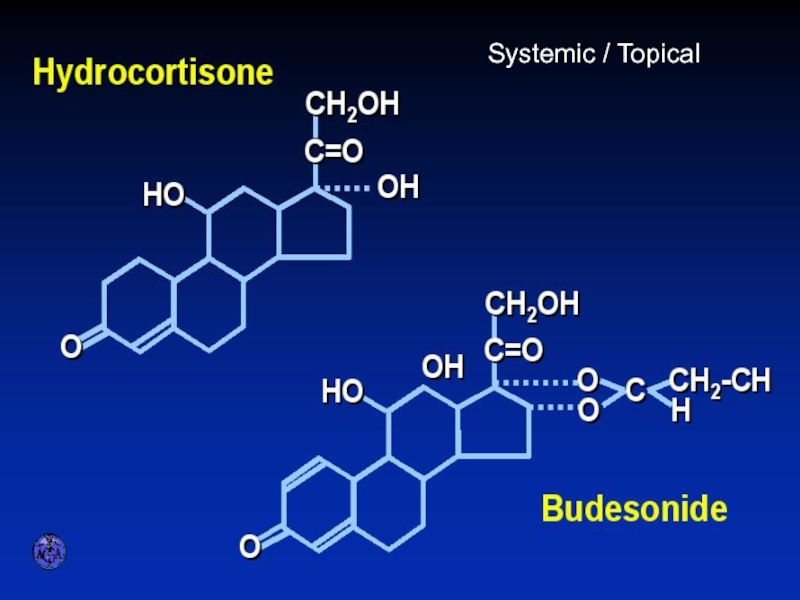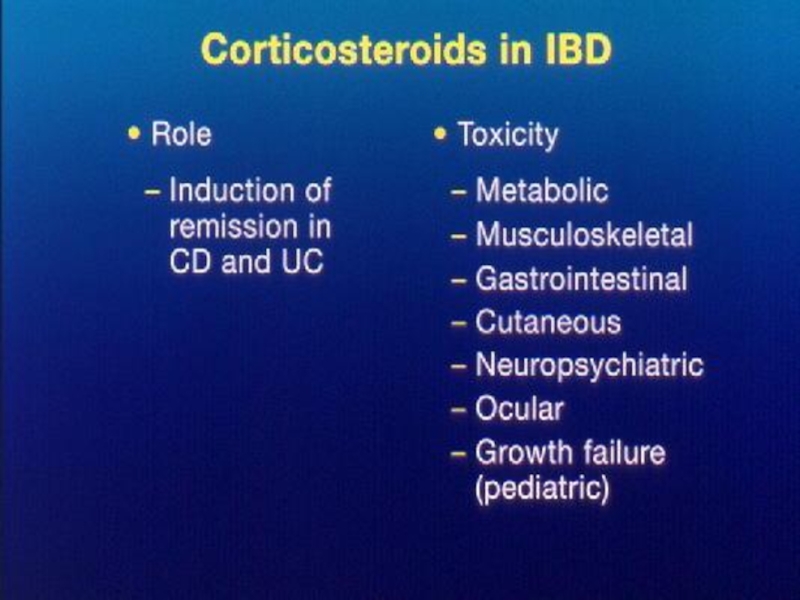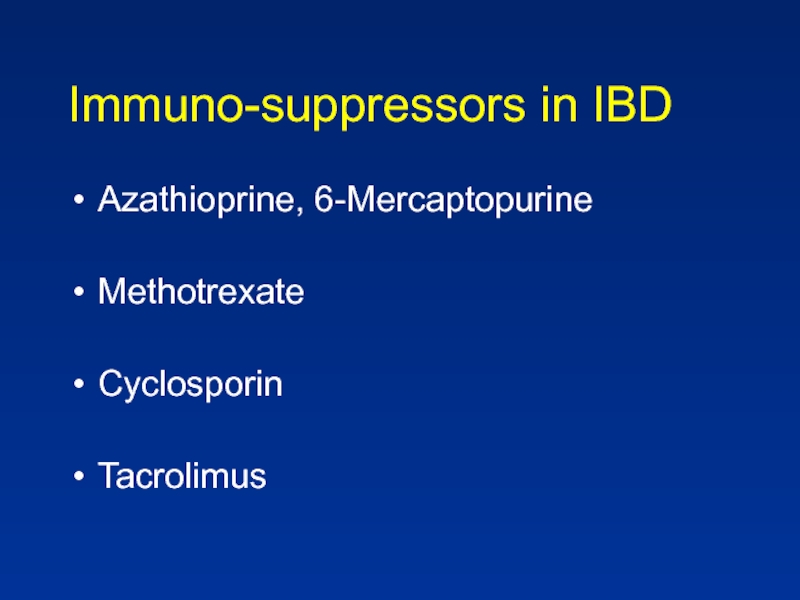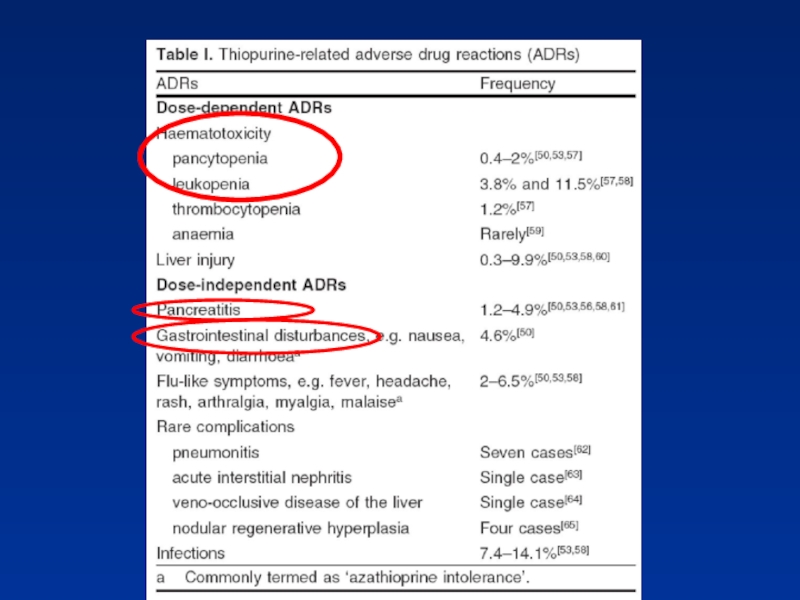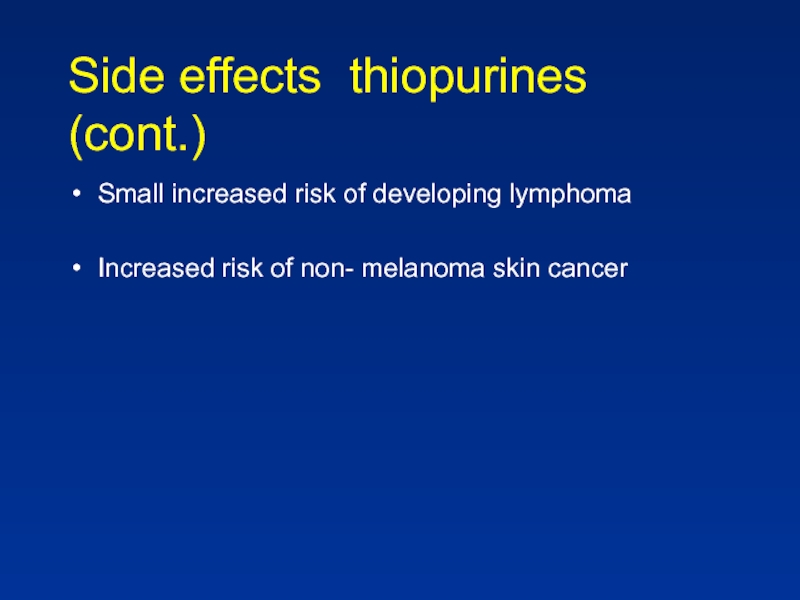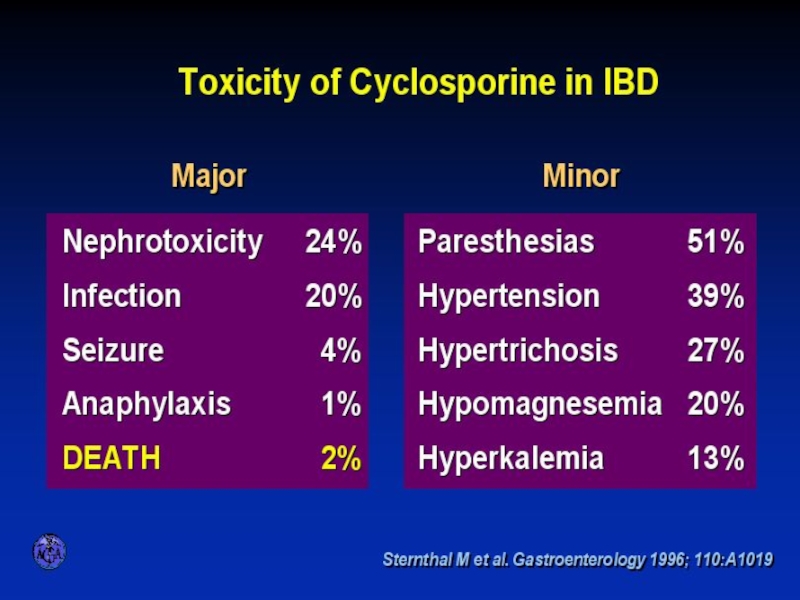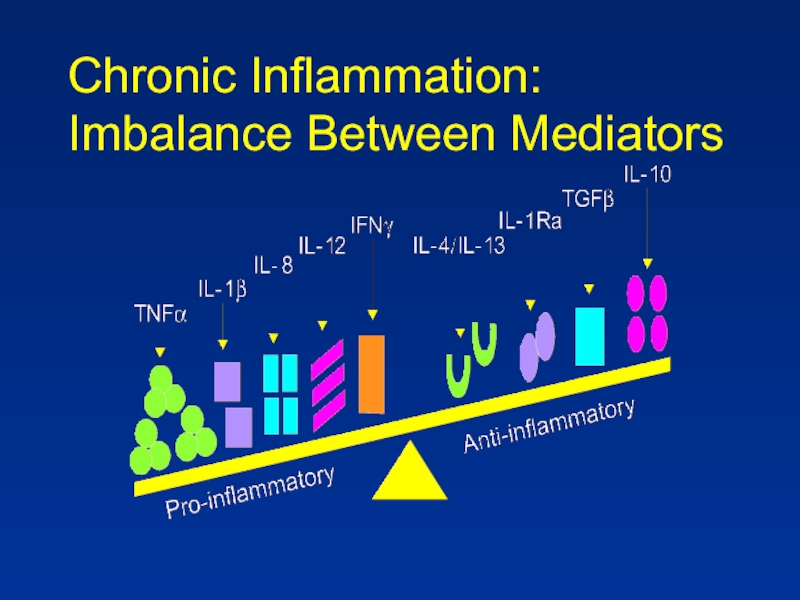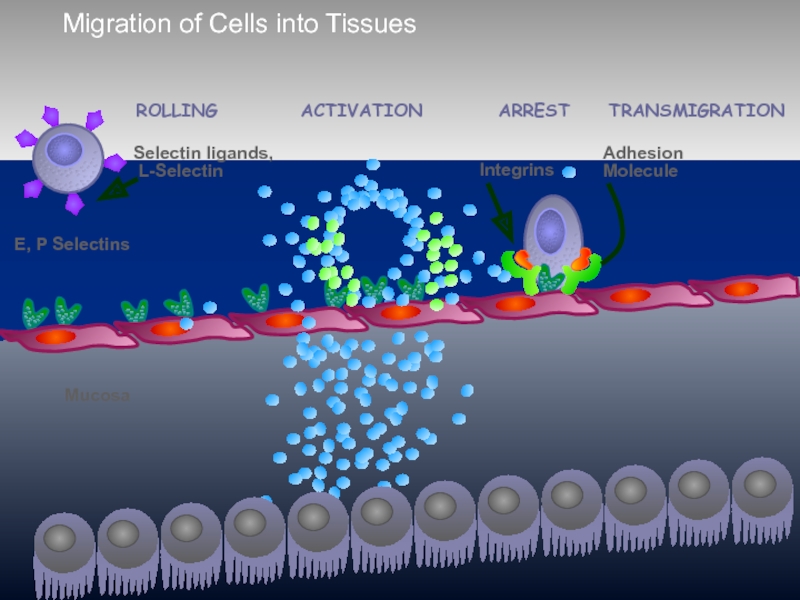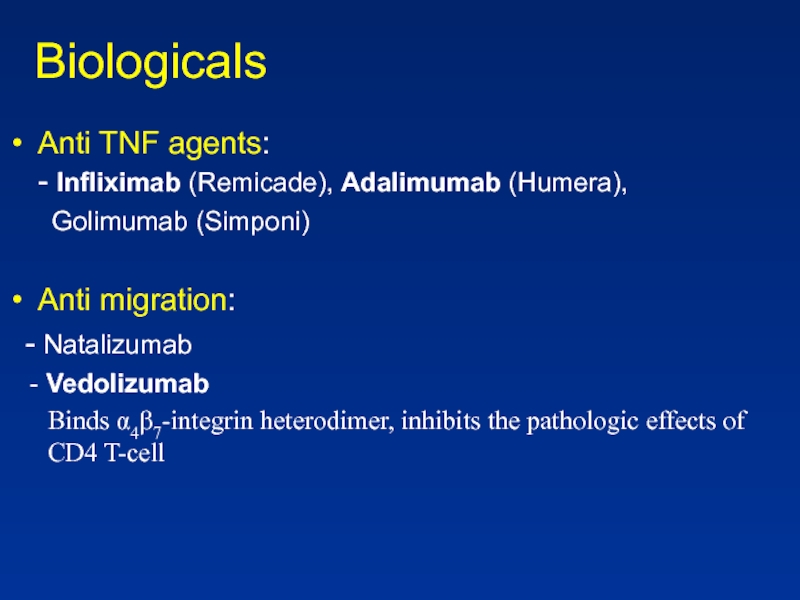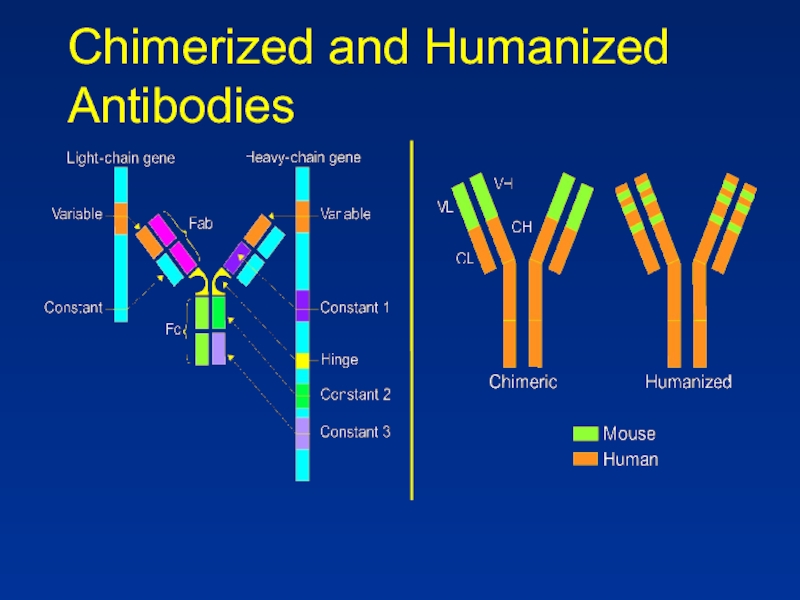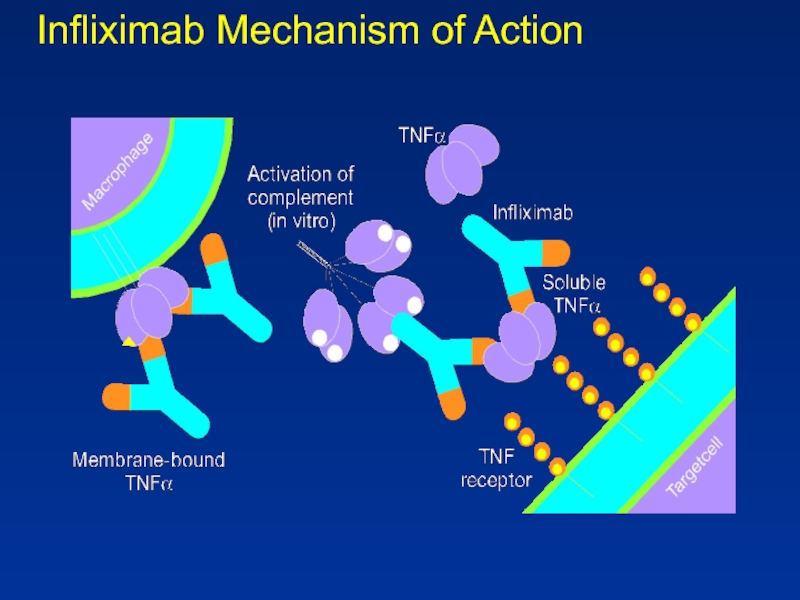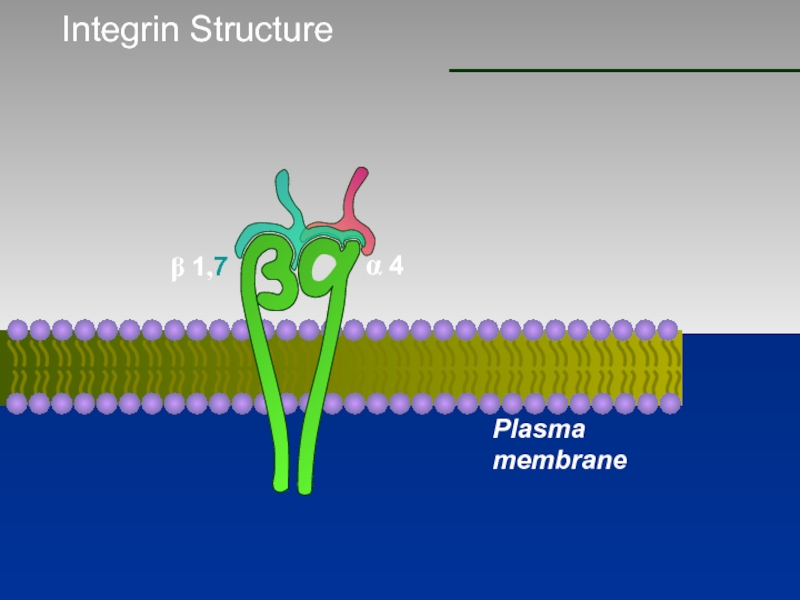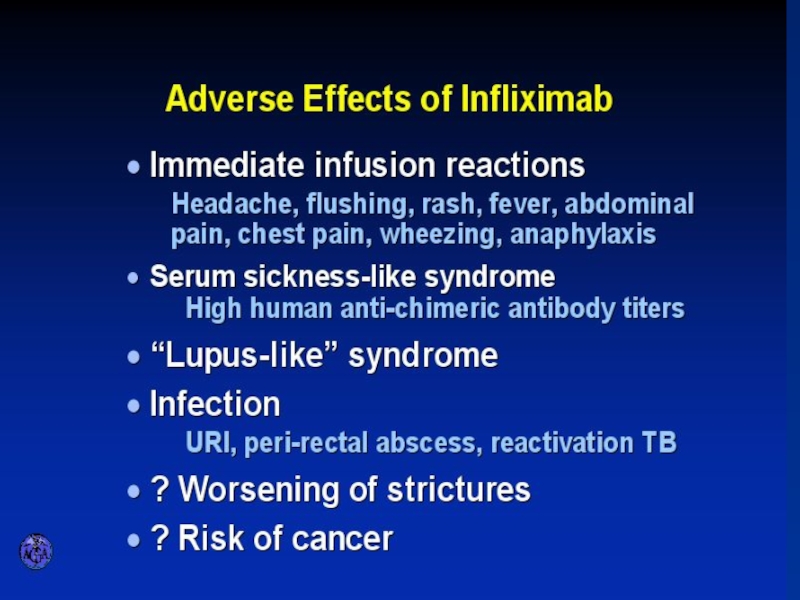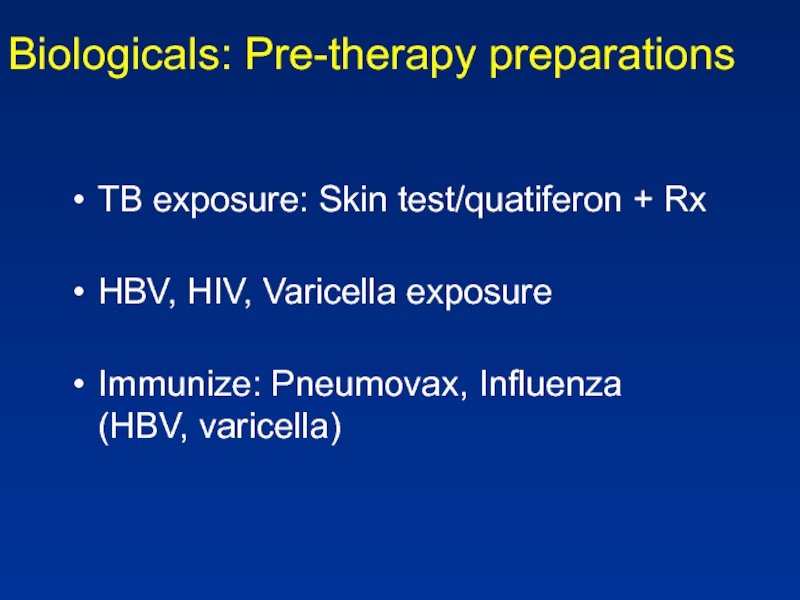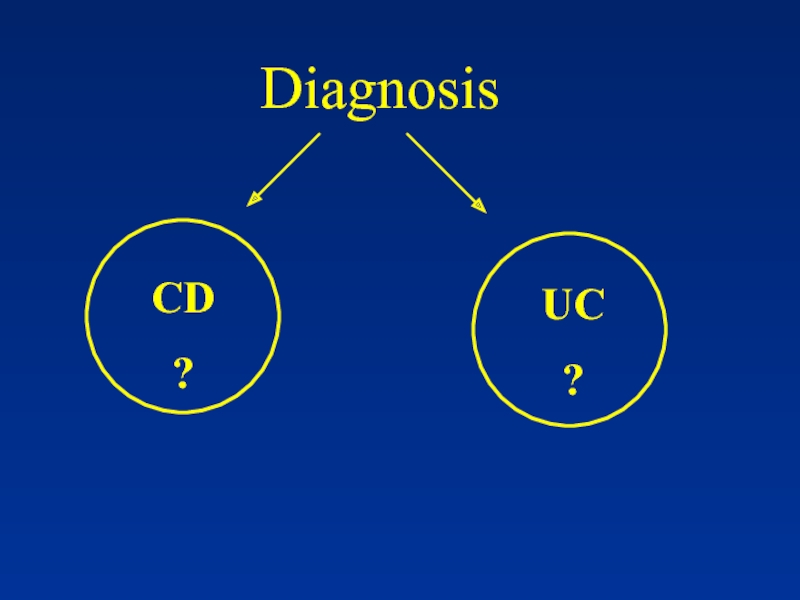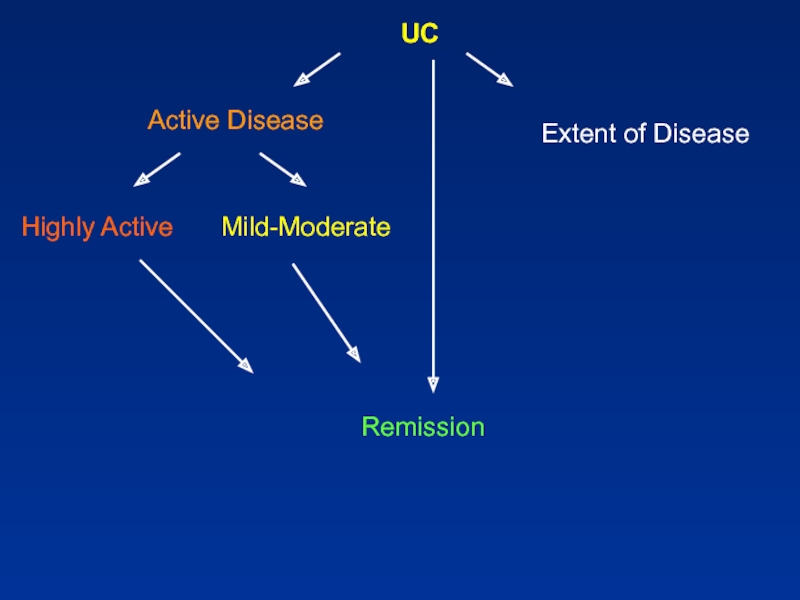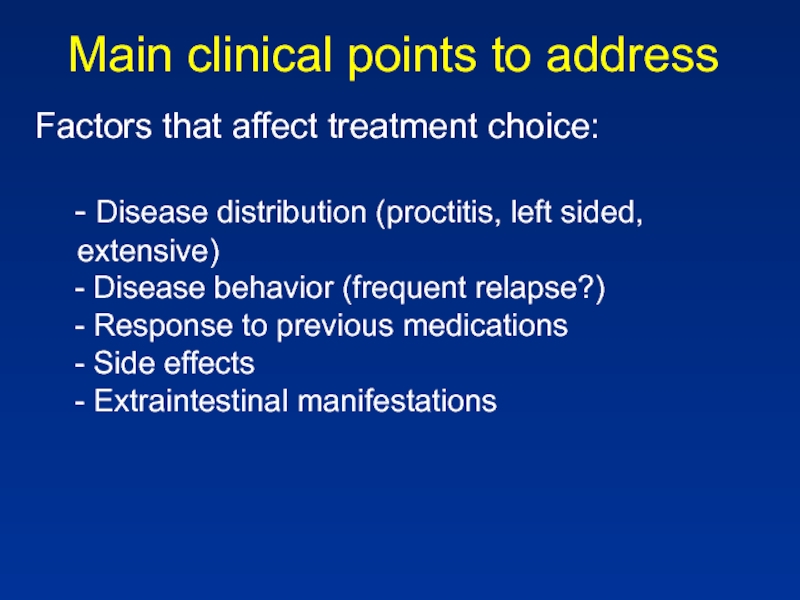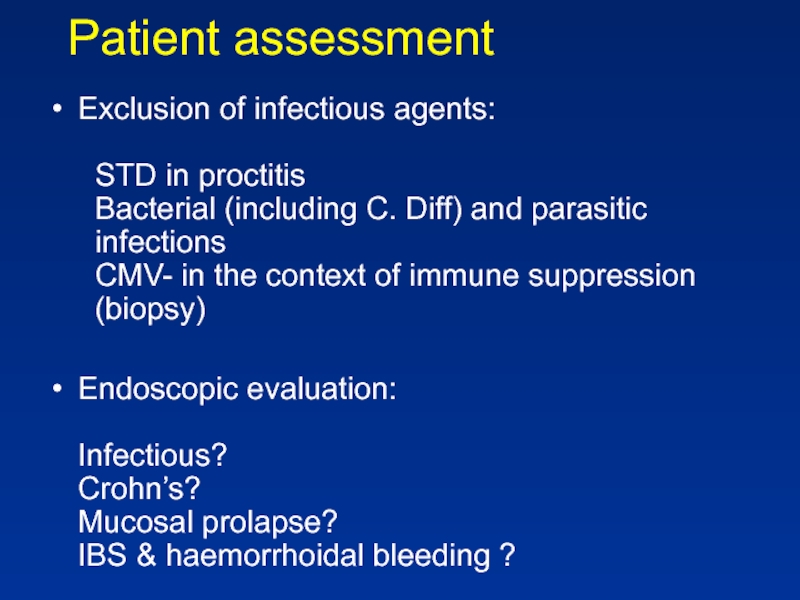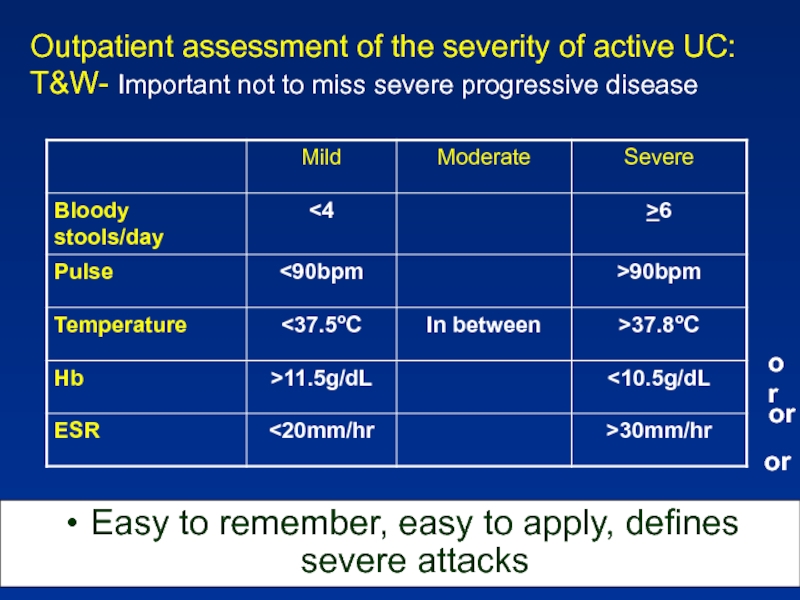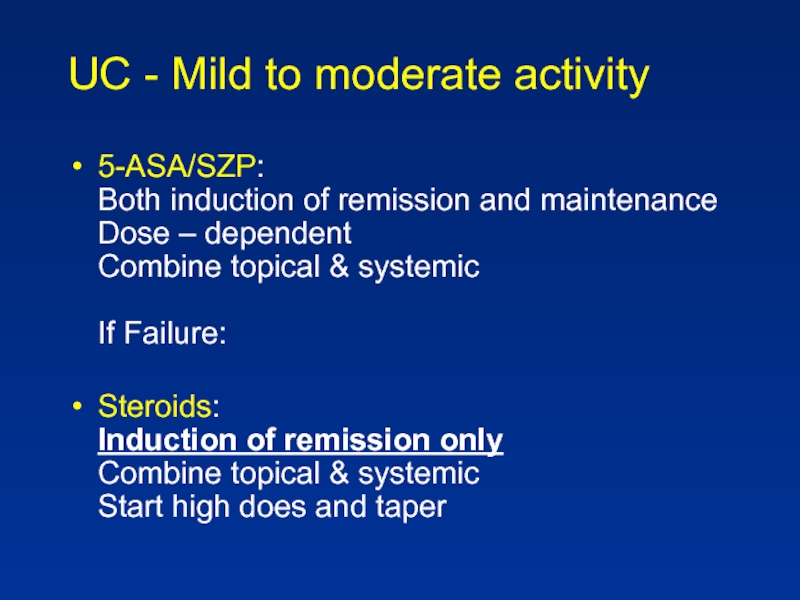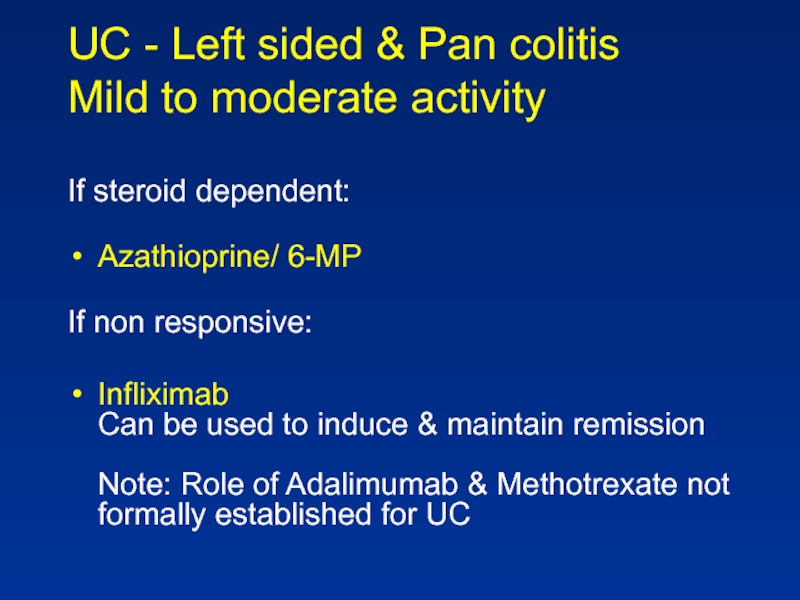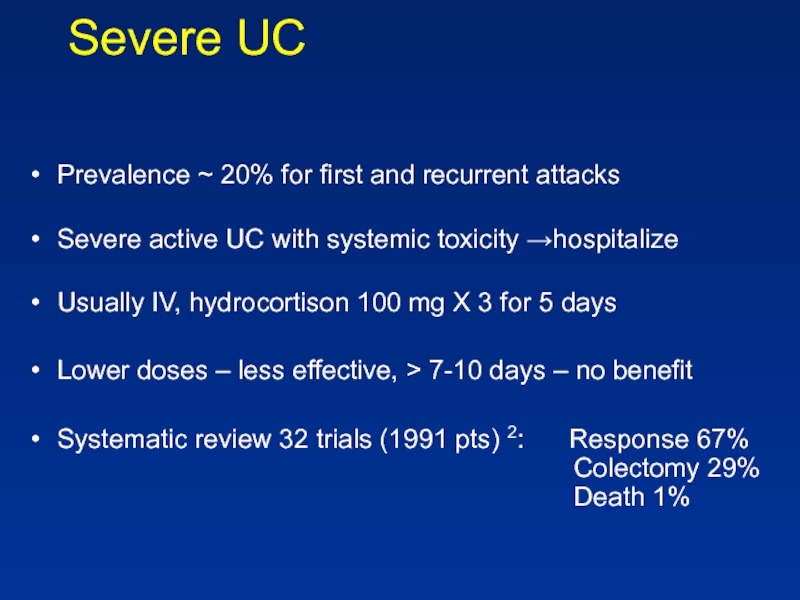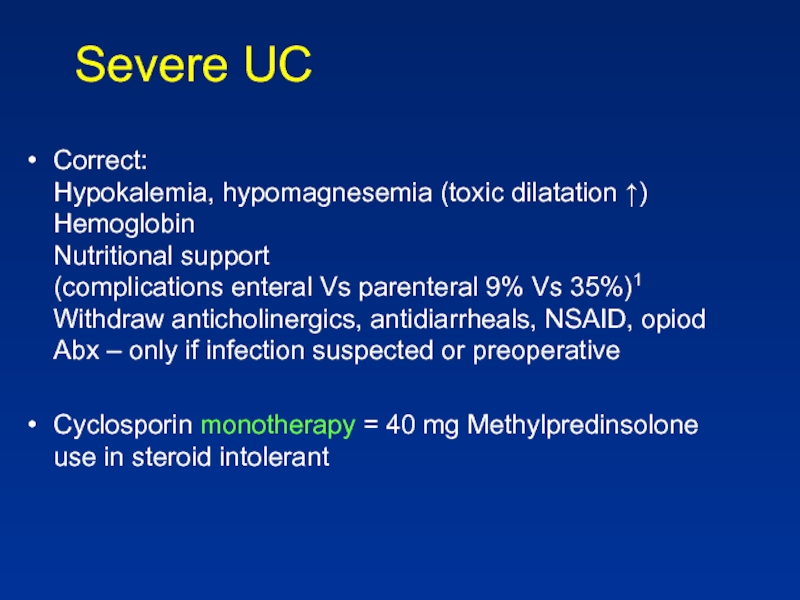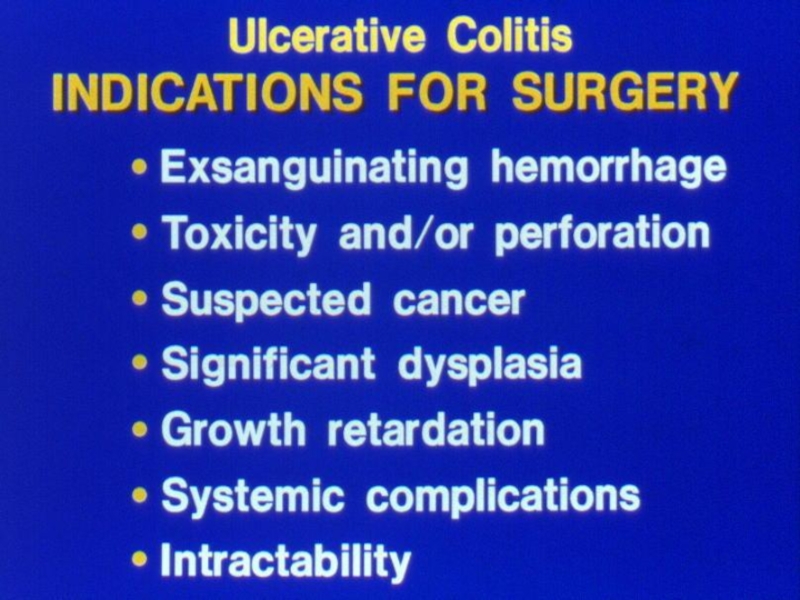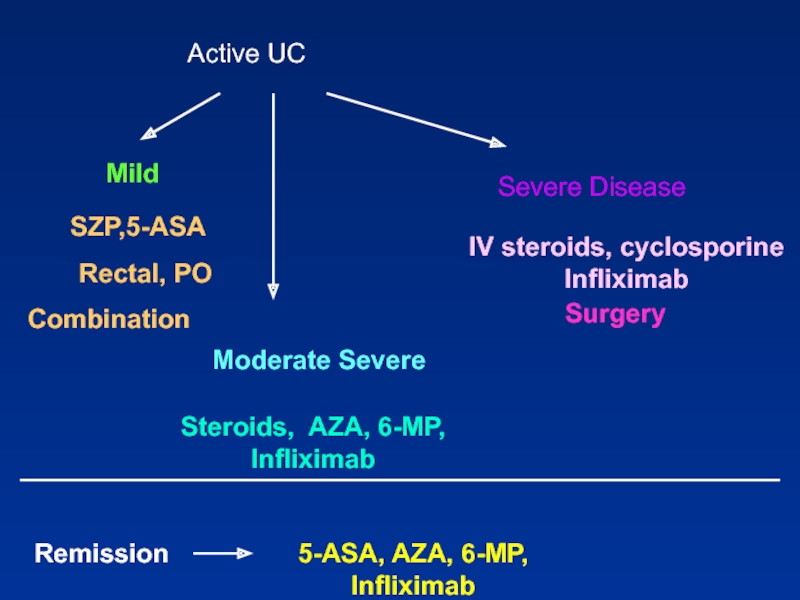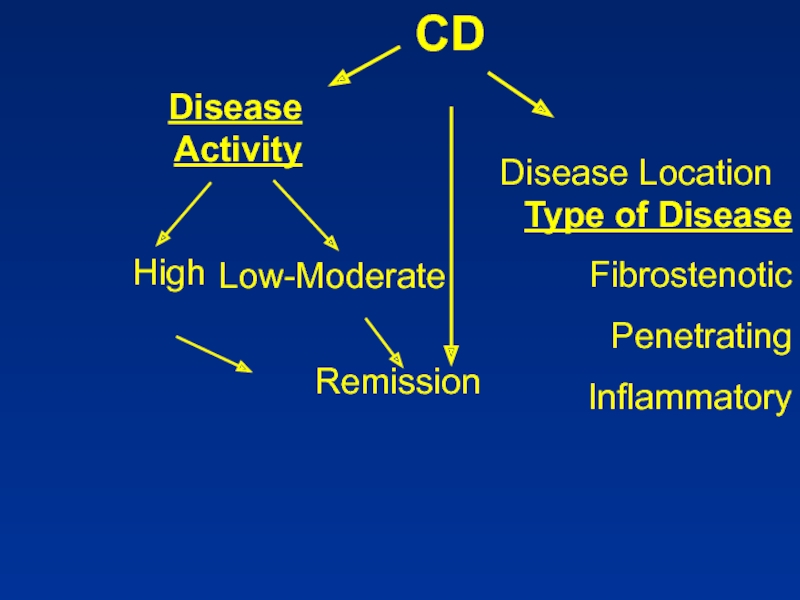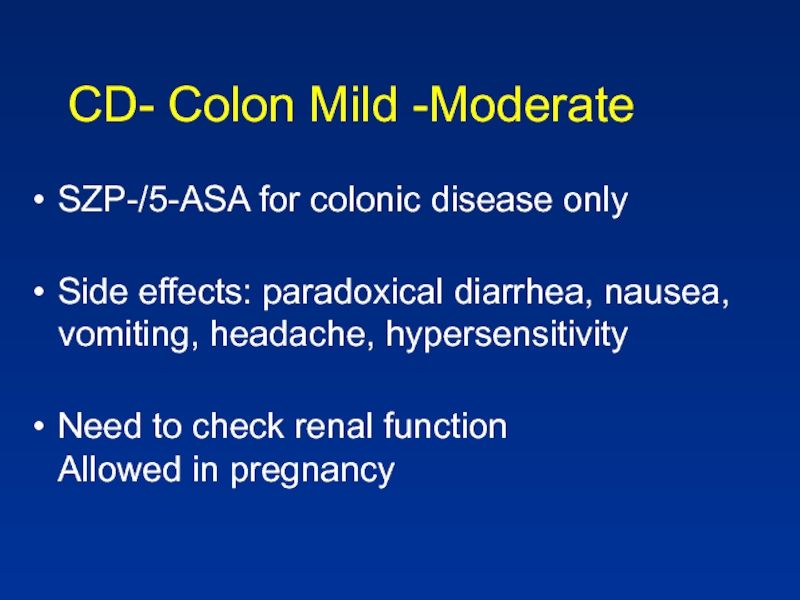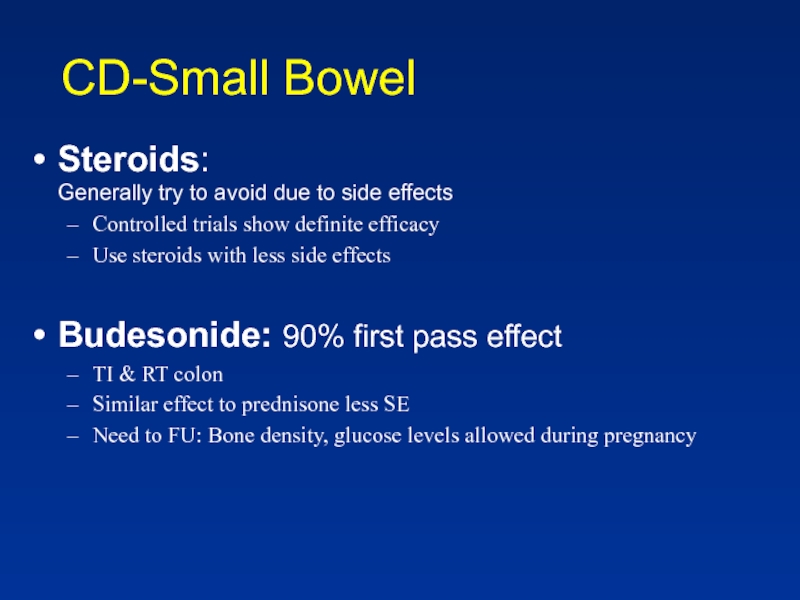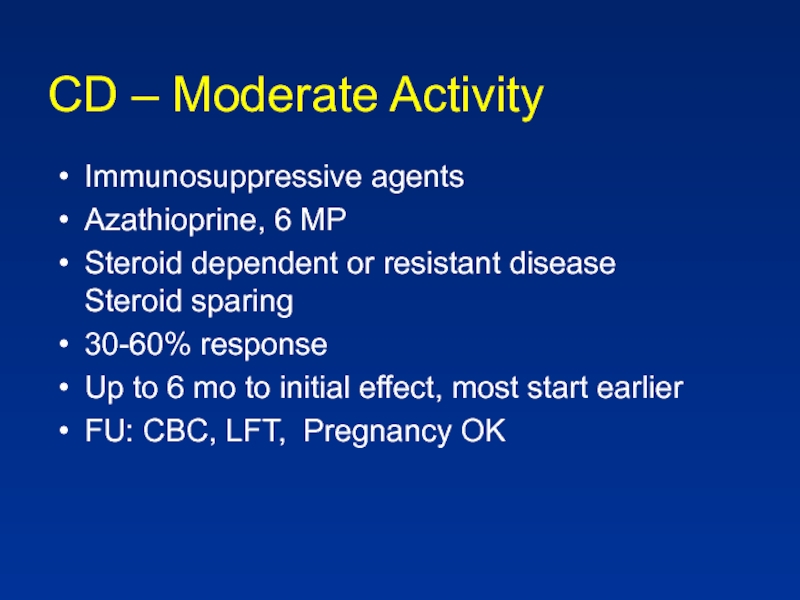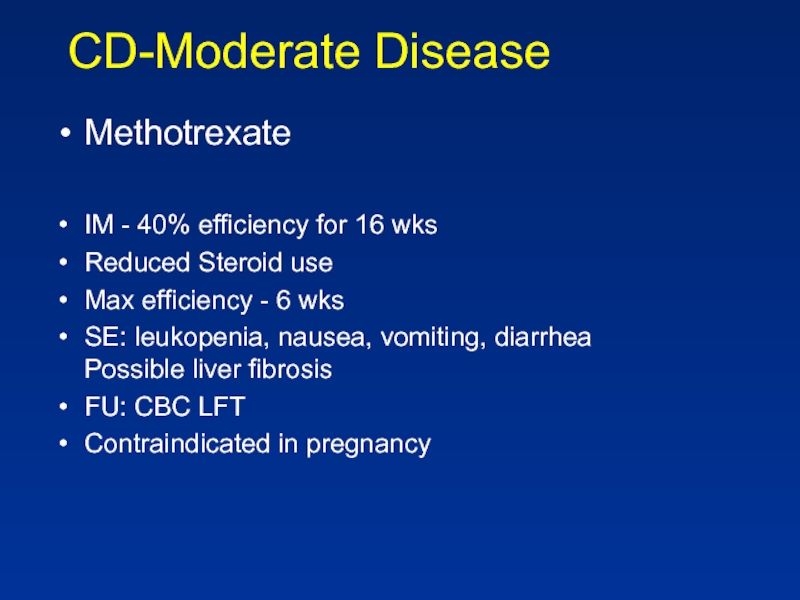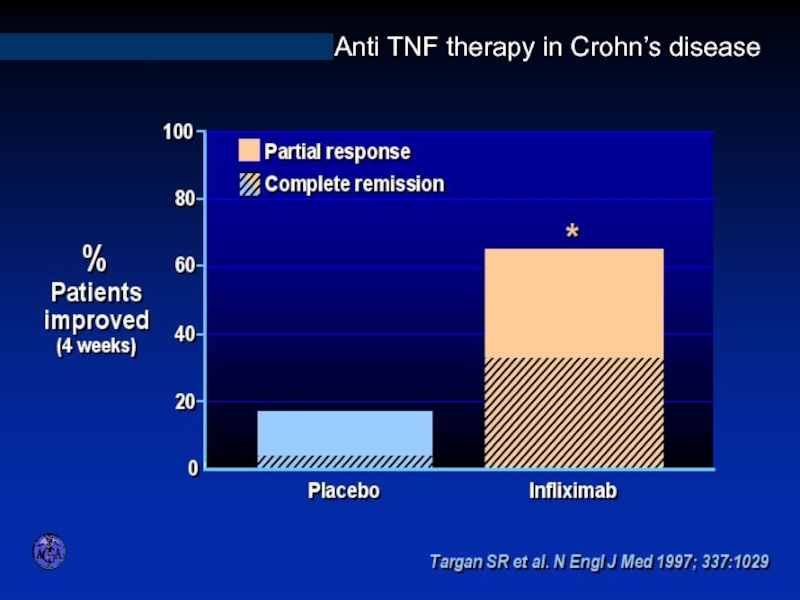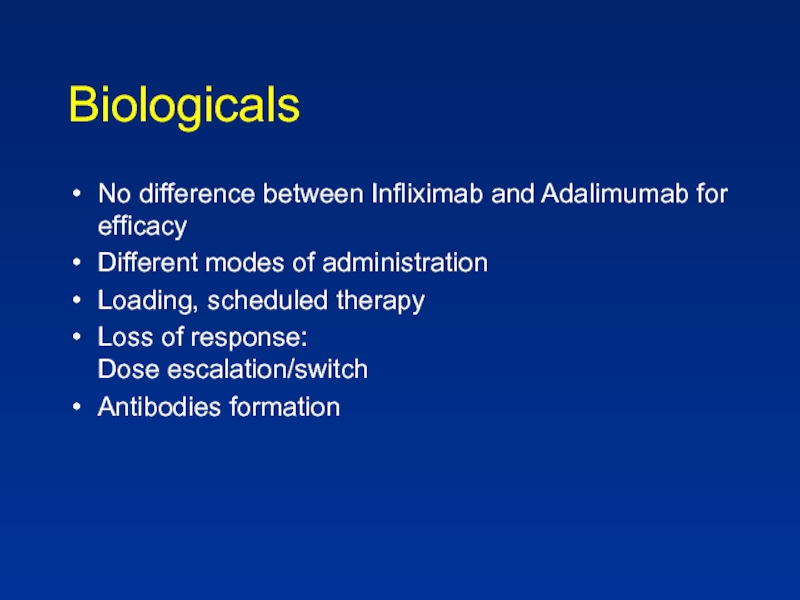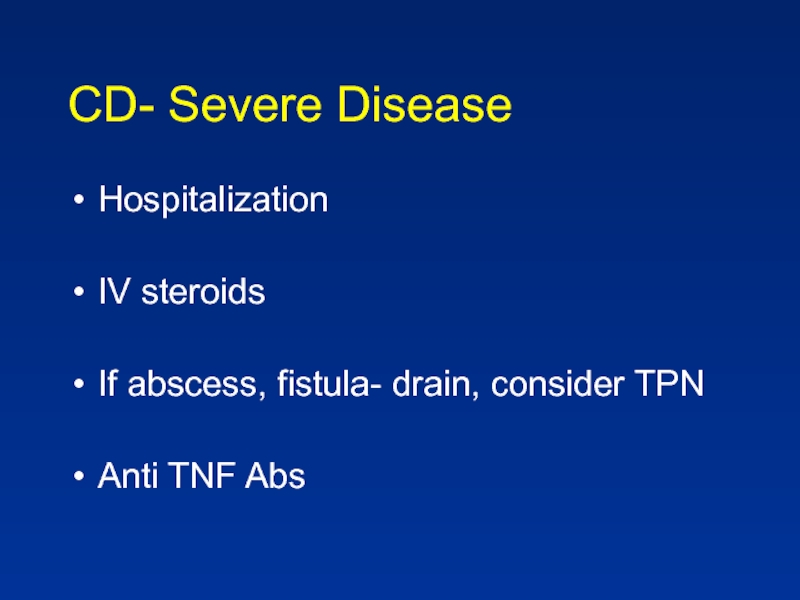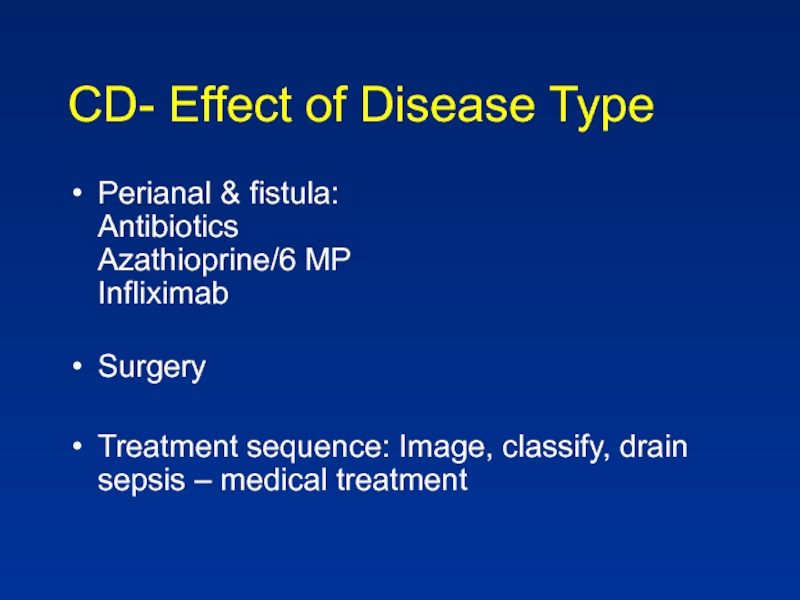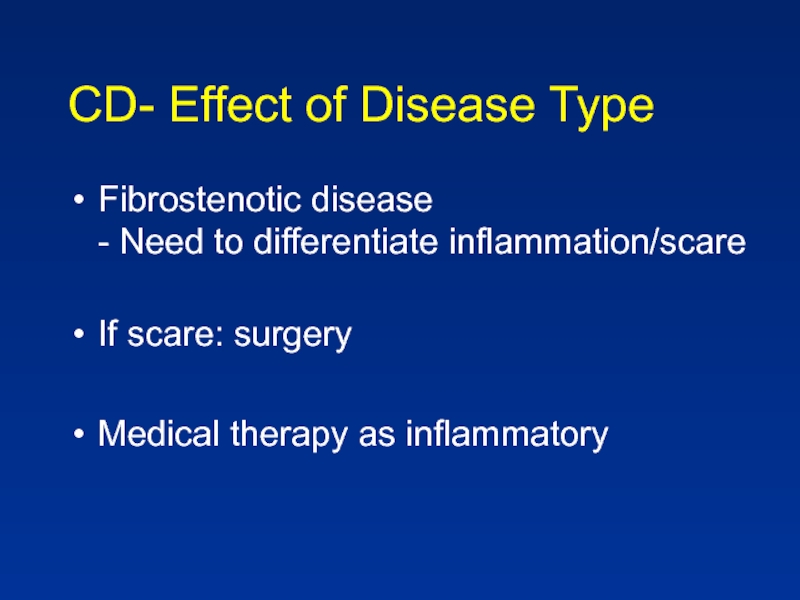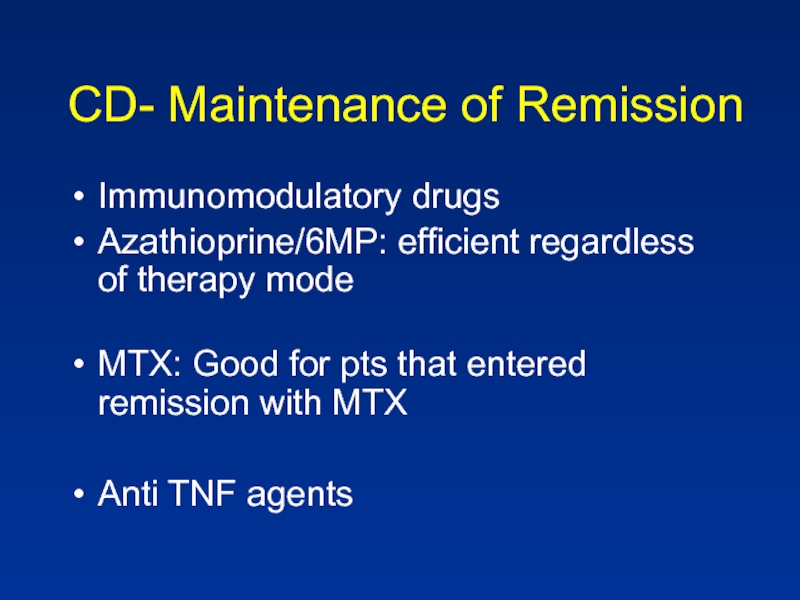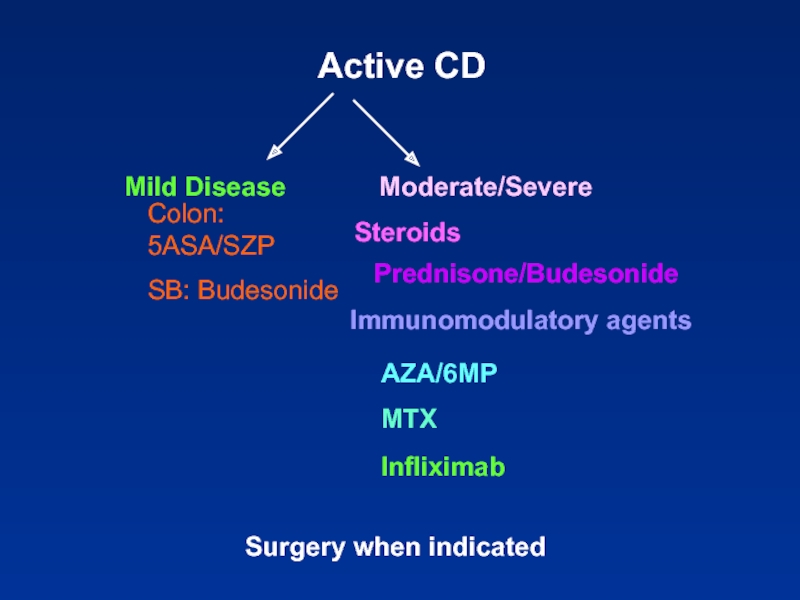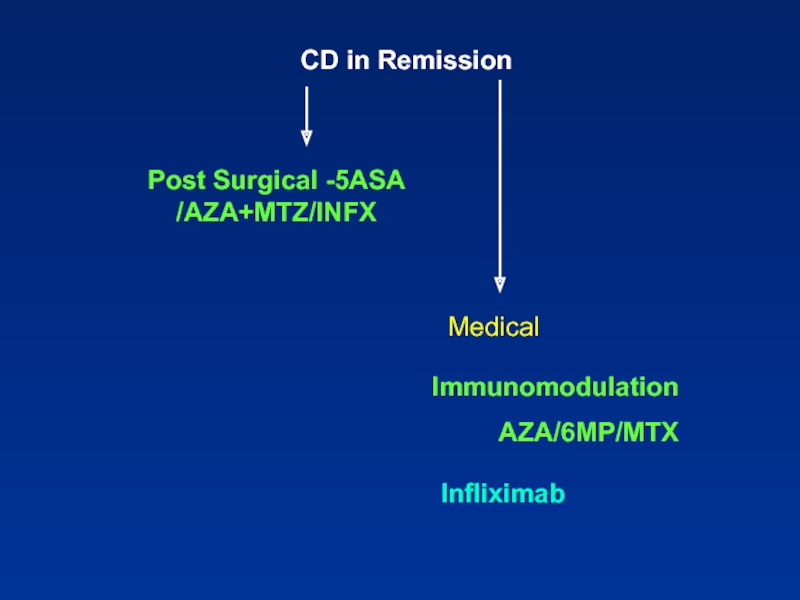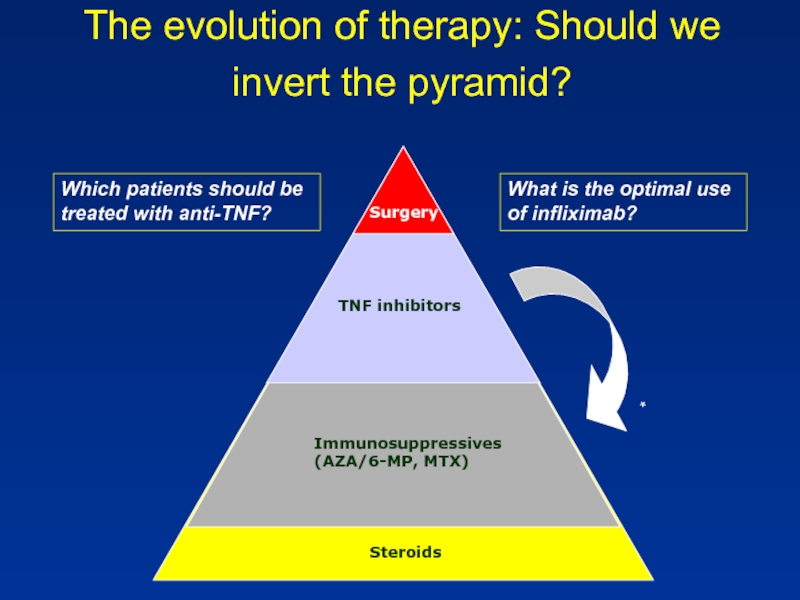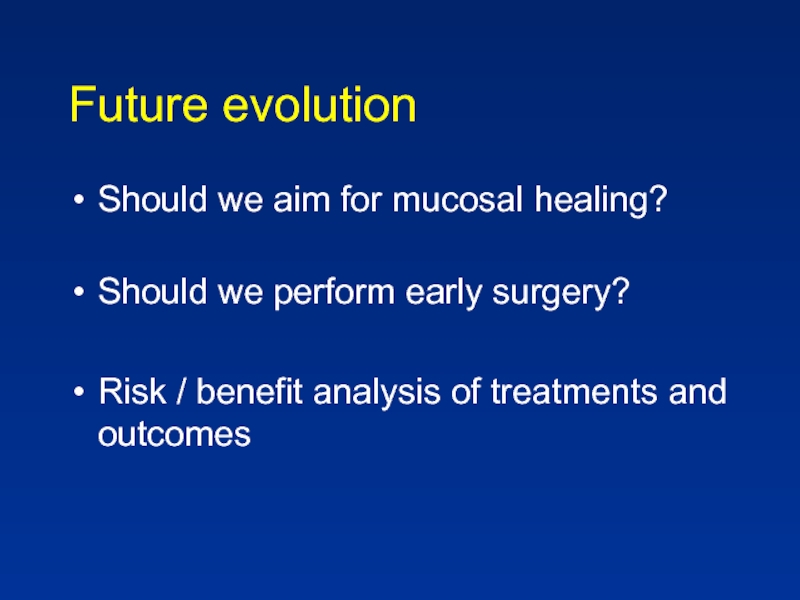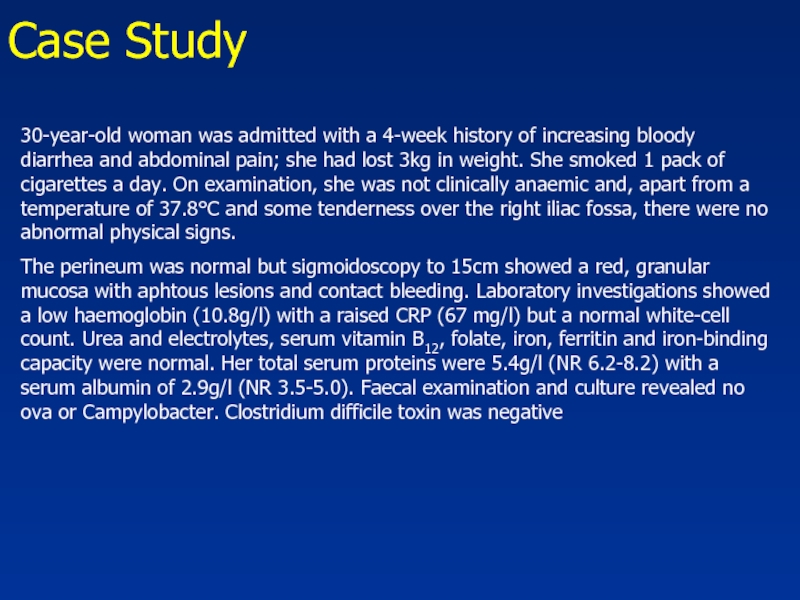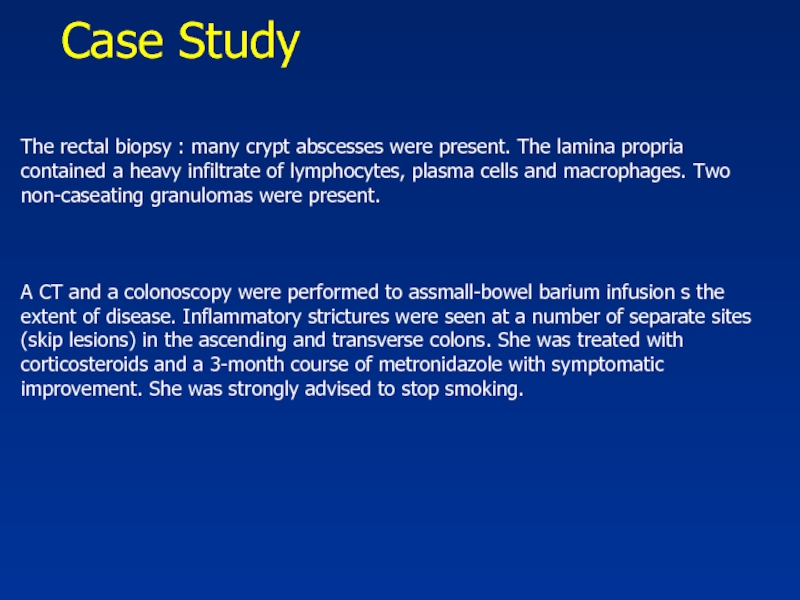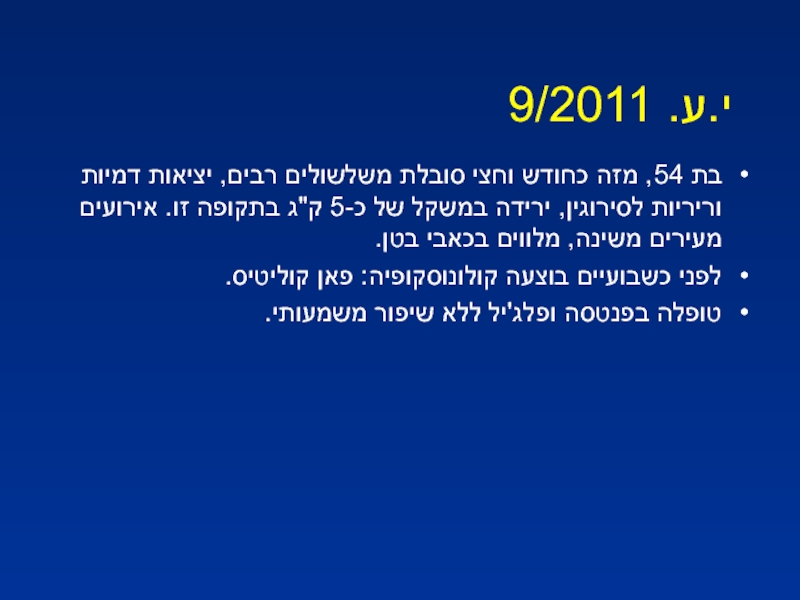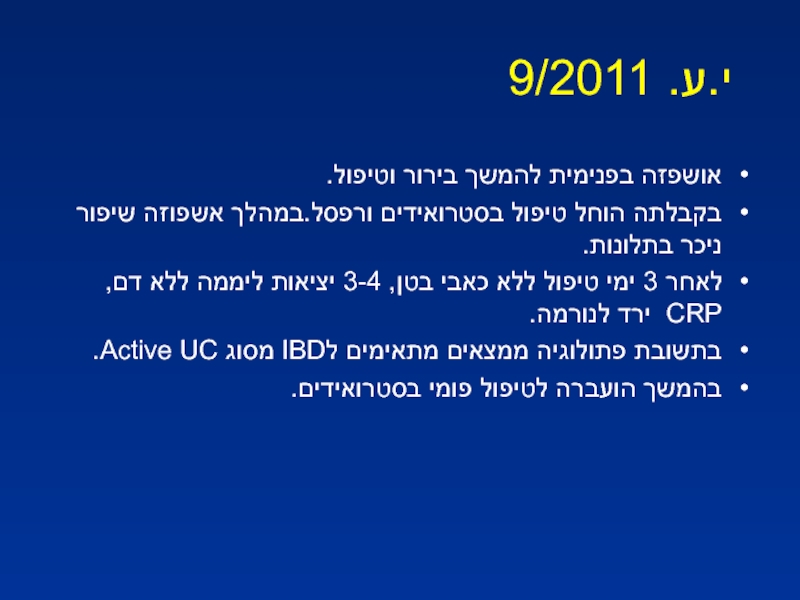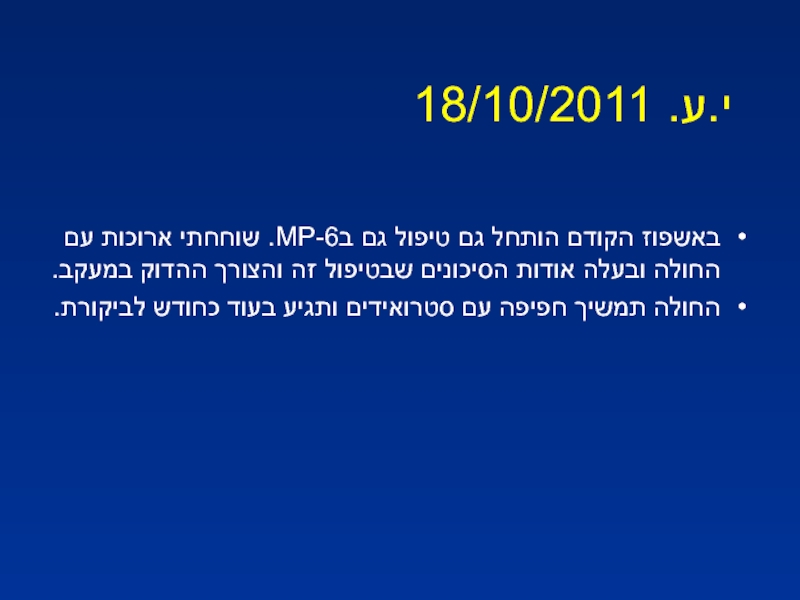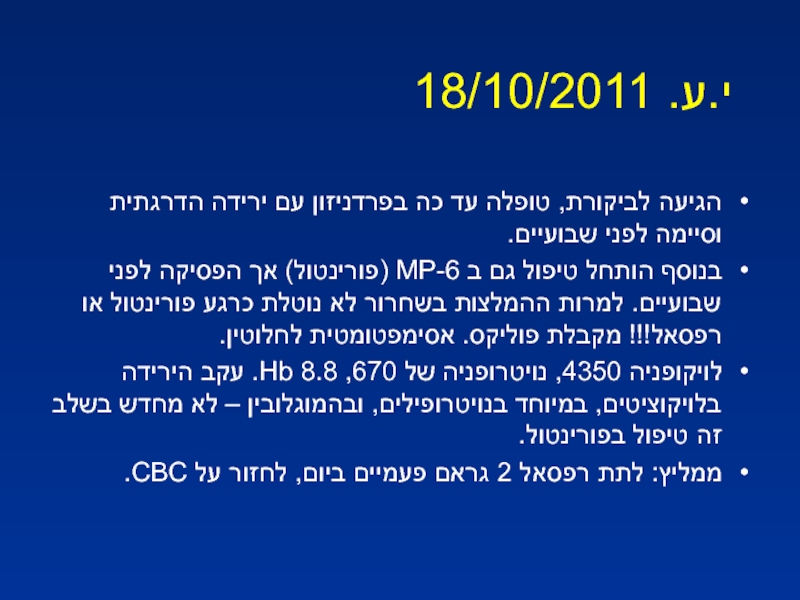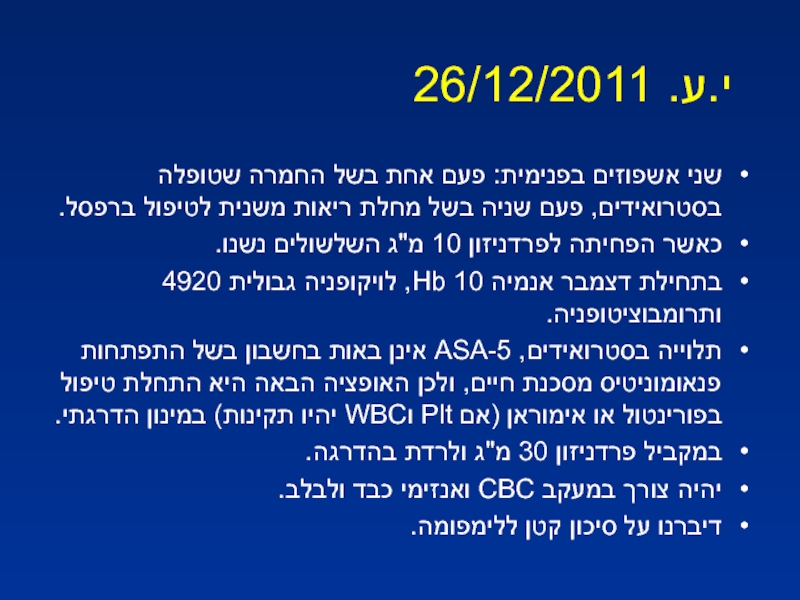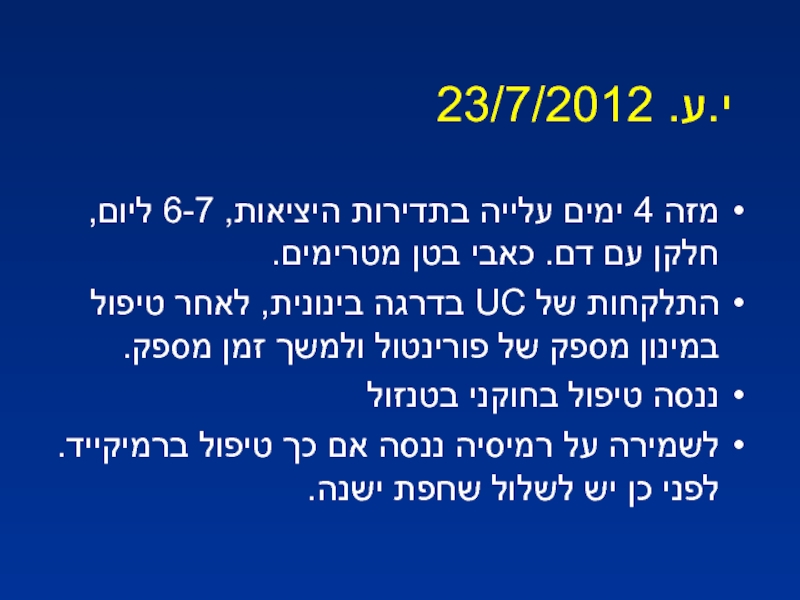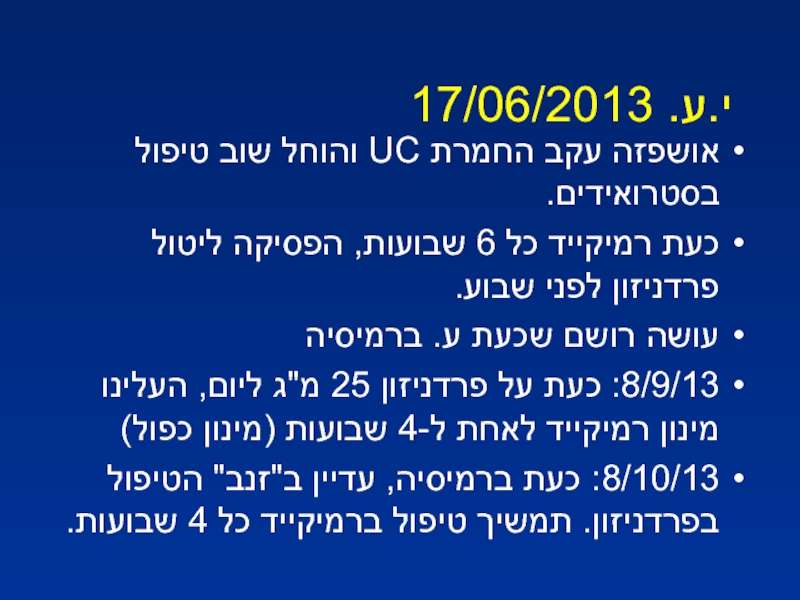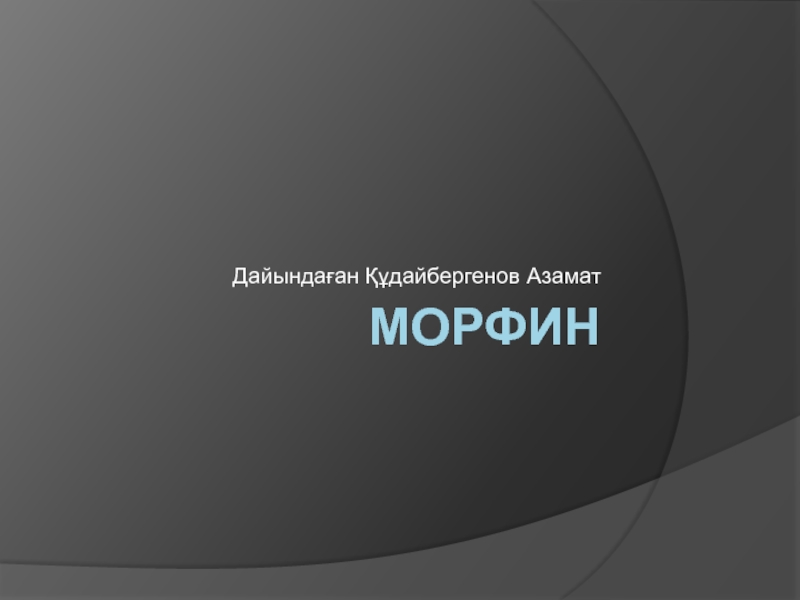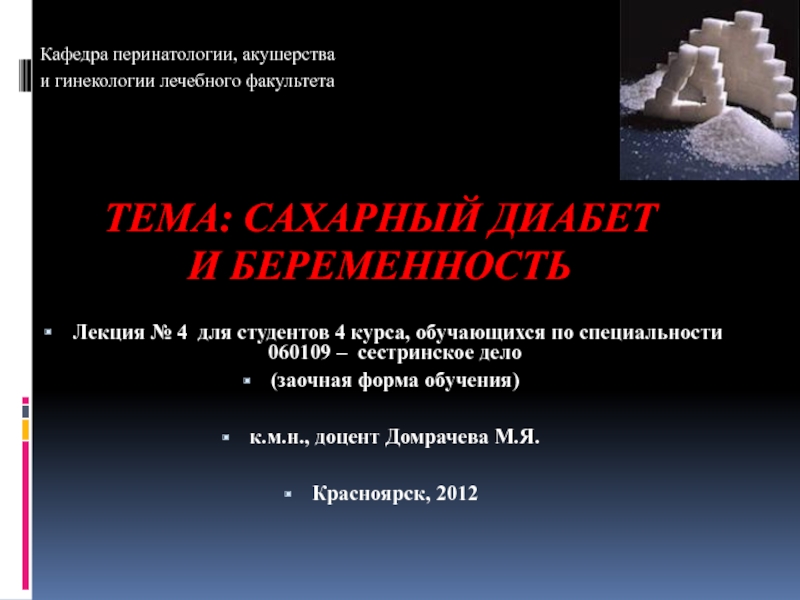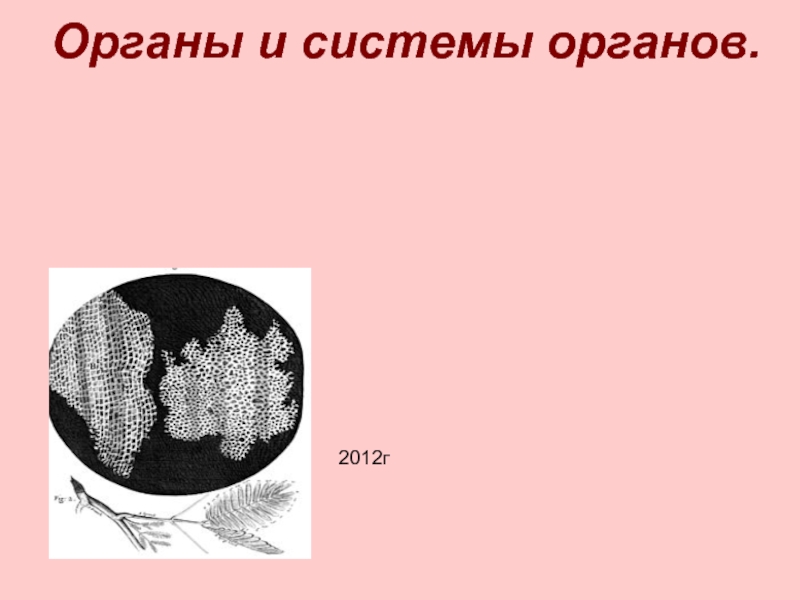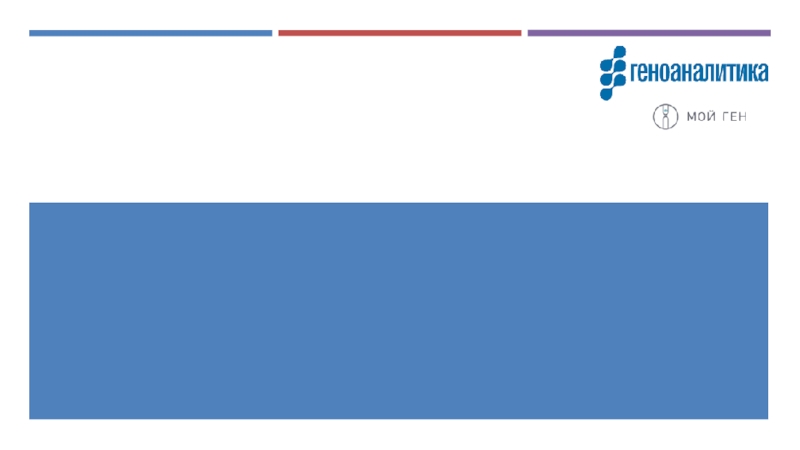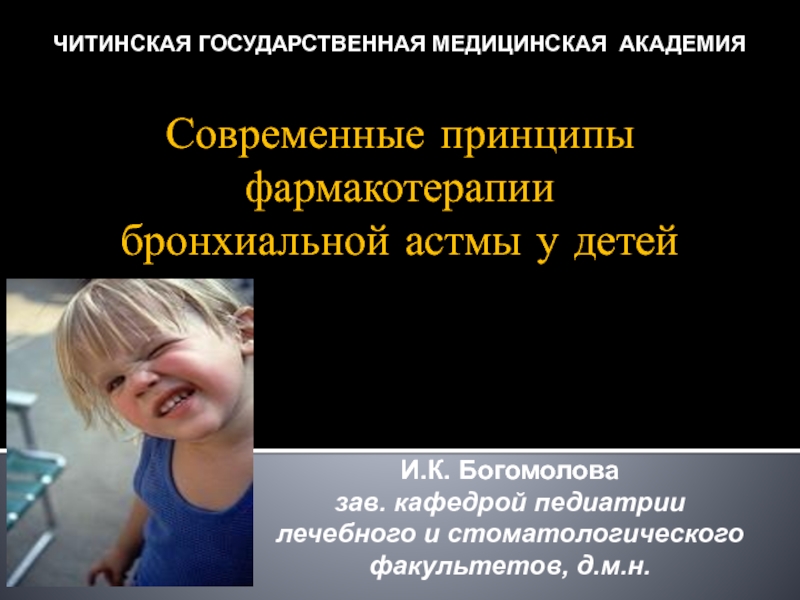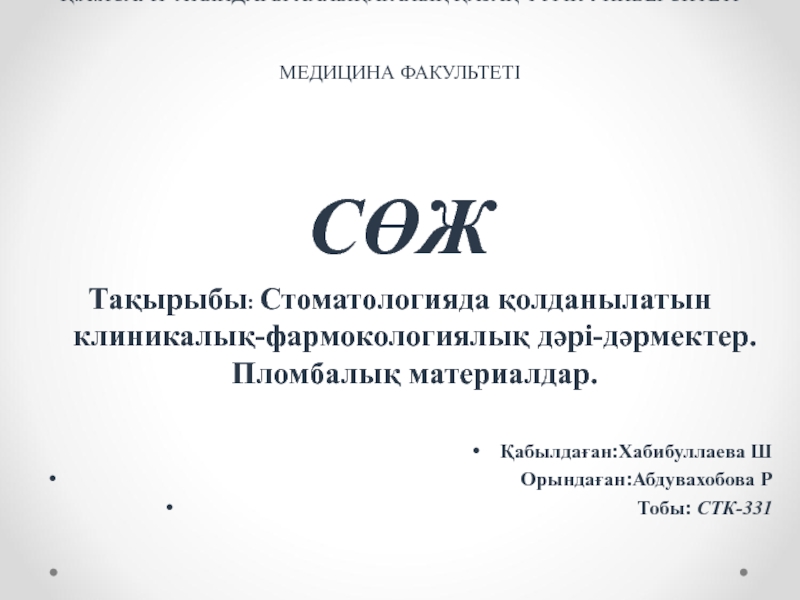- Главная
- Разное
- Дизайн
- Бизнес и предпринимательство
- Аналитика
- Образование
- Развлечения
- Красота и здоровье
- Финансы
- Государство
- Путешествия
- Спорт
- Недвижимость
- Армия
- Графика
- Культурология
- Еда и кулинария
- Лингвистика
- Английский язык
- Астрономия
- Алгебра
- Биология
- География
- Детские презентации
- Информатика
- История
- Литература
- Маркетинг
- Математика
- Медицина
- Менеджмент
- Музыка
- МХК
- Немецкий язык
- ОБЖ
- Обществознание
- Окружающий мир
- Педагогика
- Русский язык
- Технология
- Физика
- Философия
- Химия
- Шаблоны, картинки для презентаций
- Экология
- Экономика
- Юриспруденция
Inflammatory Bowel Diseases презентация
Содержание
- 1. Inflammatory Bowel Diseases
- 2. INFLAMMATORY BOWEL DISEASES
- 3. ULCERATIVE COLITIS AND CROHN’S DISEASE
- 5. Etiology and Pathogenesis Genetically predisposed individuals Chronic
- 6. Genetic Considerations CARD15 senses bacterial muramyl
- 7. VARIETIES OF COLITIS
- 8. DIFFERENTIAL DIAGNOSIS OF INFECTIOUS AND ULCERATIVE COLITIS
- 9. DIFFERENTIAL DIAGNOSIS OF IBD AND IBS
- 10. CHARACTERISTIC FEATURES OF ULCERATIVE COLITIS
- 11. Pathology Ulcerative Colitis: Macroscopic Features mucosal disease
- 12. UC Physical findings Abdomen: tenderness and distension,
- 13. UC Laboratory findings No specific
- 14. UC Clinical Features Relapsing disease (~ 80%
- 15. UC- Complications Bleeding Perforation Toxicity Cancer
- 17. Crohn’s disease (CD) Transmural disease, symptoms depend
- 18. ANATOMIC DISTRIBUTION Terminal ileum is involved in 75%
- 19. CD Small bowel Abdominal pain (mainly
- 20. CD Colon Colon: diarrhea, less rectal
- 21. CD Perianal Disease Fissures Fistulas Perirectal abscess
- 22. CD Pathology Macroscopic Features
- 23. VIENNA CLASSIFICATION
- 24. CLINICAL PATTERNS
- 25. FISTULIZATION
- 26. CONFINED PERFORATION
- 27. Natural history of CD accumulation of disease
- 28. APPROACH TO DIFFERENTIAL DIAGNOSIS OF ULCERATIVE VERSUS CROHN’S COLITITS
- 29. Extraintestinal Manifestations Arthritis - Peripheral -dependent on
- 30. Extra-intestinal manifestations, co-morbidities and complications of CD Uveitis1 Pyoderma gangrenosum2,3 Psoriasis4 Spondyloarthropathy5
- 31. Extraintestinal Manifestations Rheumatologic Peripheral arthritis- 15–20%
- 32. Extraintestinal Manifestations Rheumatologic Sacroilitis Symmetric equally in
- 33. Extraintestinal manifestations - Skin Pyoderma gangrenosum- more
- 35. Extraintestinal Manifestations - Skin - Erythema
- 36. Erythema nodosum
- 37. Extraintestinal Manifestations Ocular: The most common are
- 38. Extraintestinal Manifestations Urologic calculi, ureteral obstruction, and
- 39. Extraintestinal Manifestations Thromboembolic Disorders increased risk
- 40. Diagnosis History - How long? -
- 41. Diagnosis Laboratory tests- non specific and
- 42. Diagnosis Stool: Steatorrhea (mild), WBC in stool,
- 43. Diagnosis Determine anatomic involvement Determine nature of involvement (UC Vs CD Vs others)
- 44. Diagnosis Endoscopic examinations: Rectosigmoidoscopy- rectum? Mucosal morphology?
- 45. ENDOSCOPIC SPECTRUM OF SEVERITY
- 46. Tissue inflammatory infiltration by lymphocytes, plasma cells,
- 47. ENDOSCOPIC APPEARANCES CD aphthae stellate ulcer longitudinal ulcer Macroulcerations and pseudoplyps
- 48. Diagnosis Radiology Barium enema: fistula, sinus
- 49. TRANSVERSE COLON STRICTURE
- 50. SPECTRUM OF ILEITIS marked edema and nodularity
- 51. Diagnosis CT – replaced SBFT, allows for
- 52. CT can asses inflammation, bowel wall thikening,
- 53. DISTINGUISHING FEATURES OF CROHN’S DISEASE
- 54. GOALS OF THERAPY
- 55. CONVENTIONAL DRUG THERAPIES Biologics Anti- TNF Anti-cytokine Anti Migration
- 56. SULFASALAZINE
- 57. AMINOSALICYLATES
- 58. AMINOSALICYLATE DISTRIBUTION
- 59. STEROID PREPARATIONS Systemic / Topical
- 61. Immuno-suppressors in IBD Azathioprine, 6-Mercaptopurine Methotrexate Cyclosporin Tacrolimus
- 63. Side effects thiopurines (cont.) Small increased risk
- 64. TOXICITY OF CYCLOSPORINE
- 65. Chronic Inflammation: Imbalance Between Mediators
- 66. Migration of Cells into Tissues E,
- 67. Biologicals Anti TNF agents: - Infliximab
- 68. Chimerized and Humanized Antibodies
- 69. Infliximab Mechanism of Action
- 70. Integrin Structure β 1,7 α 4 Plasma membrane
- 71. ADVERSE EFFECTS OF INFLIXIMAB
- 72. Biologicals: Pre-therapy preparations TB exposure: Skin
- 73. Diagnosis
- 74. UC Active Disease Highly Active Mild-Moderate Remission Extent of Disease
- 75. Main clinical points to address Factors
- 76. Patient assessment Exclusion of infectious agents:
- 77. Outpatient assessment of the severity of active
- 78. UC - Mild to moderate activity
- 79. UC - Left sided & Pan colitis
- 80. Severe UC Prevalence ~ 20% for first
- 81. Severe UC Correct: Hypokalemia, hypomagnesemia (toxic dilatation
- 83. Active UC Mild Steroids, AZA, 6-MP, Infliximab
- 84. CD
- 85. CD- Colon Mild -Moderate SZP-/5-ASA for colonic
- 86. CD-Small Bowel Steroids: Generally try to avoid
- 87. CD – Moderate Activity Immunosuppressive agents
- 88. CD-Moderate Disease Methotrexate IM - 40%
- 89. INFLIXIMAB IN ACTIVE CROHN’S DISEASE Anti TNF therapy in Crohn’s disease
- 90. Biologicals No difference between Infliximab and Adalimumab
- 91. CD- Severe Disease Hospitalization IV steroids
- 92. CD- Effect of Disease Type Perianal &
- 93. CD- Effect of Disease Type Fibrostenotic disease
- 94. CD- Maintenance of Remission Not Steroids
- 95. CD- Maintenance of Remission Immunomodulatory drugs Azathioprine/6MP:
- 96. Active CD Colon: 5ASA/SZP SB: Budesonide Steroids
- 97. CD in Remission Medical Immunomodulation AZA/6MP/MTX Infliximab
- 98. The evolution of therapy: Should we invert
- 99. Future evolution Should we aim for mucosal
- 100. Case Study 30-year-old woman was admitted with
- 101. Case Study The rectal biopsy : many
- 102. י.ע. 9/2011 בת 54, מזה
- 103. אושפזה בפנימית להמשך בירור וטיפול. בקבלתה
- 104. באשפוז הקודם הותחל גם טיפול גם
- 105. י.ע. 18/10/2011 הגיעה לביקורת, טופלה עד
- 106. י.ע. 26/12/2011 שני אשפוזים בפנימית:
- 107. י.ע. 23/7/2012 מזה 4 ימים עלייה
- 108. י.ע. 17/06/2013 אושפזה עקב החמרת UC
Слайд 5Etiology and Pathogenesis
Genetically predisposed individuals
Chronic activation of the mucosal immune system
Inappropriate response to the endogenous microbial flora within the intestine, with or without some component of autoimmunity
Слайд 6Genetic Considerations
CARD15
senses bacterial muramyl dipeptide and regulates intracellular signaling
expressed by
Loss-of-function mutations in CARD15 are highly associated with CD
decreased intestinal antimicrobial activity by diminishing defensin production by Paneth cells
excess NF-kB activation
Слайд 11Pathology
Ulcerative Colitis: Macroscopic Features
mucosal disease that usually involves the rectum and
40–50%-rectum and rectosigmoid, 30–40%- extending beyond the sigmoid, 20%- total colitis
Proximal spread occurs in continuity without areas of uninvolved mucosa
terminal ileum (1-2 cm) in 10–20% of patients- backwash ileitis
biopsies from normal-appearing mucosa are usually abnormal
mucosa is erythematous, hemorrhagic, edematous, and ulcerated
inflammatory polyps (pseudopolyps) may be present as a result of epithelial regeneration
mucosa may appear normal in remission
In prolonged disease mucosa is atrophic and featureless and the entire colon becomes narrowed and shortened
Слайд 12UC Physical findings
Abdomen: tenderness and distension, but can be normal
Extra
Usually normal perineum
Слайд 13UC Laboratory findings
No specific findings
ESR ↑, CRP ↑, anemia (chronic disease,
Слайд 14UC Clinical Features
Relapsing disease (~ 80% 1yr)
Symptoms usually parallel disease extent
(More
Proctitis may be hard to treat and cause blood loss and disturbing tenesmus
Disease may extent more proximally with follow up (~40% in proctitis, ~ 10% in left sided)
Слайд 17Crohn’s disease (CD)
Transmural disease, symptoms depend on site of involvement and
Abdominal pain, diarrhea (usually not bloody), weight loss, fever
Mouth to anus
Слайд 19CD Small bowel
Abdominal pain (mainly RLQ), may be constant and
Diarrhea
Vomiting (obstruction)
Weight loss, fatigue, fever
Acute presentation may resemble appendicitis
May present as FUO or chronic subtle disease
Слайд 20CD Colon
Colon: diarrhea, less rectal bleeding (less colon & rectum
Perianal involvement: fissures, fistulas, perirectal abscess
Слайд 22CD Pathology
Macroscopic Features
terminal ileum is involved in 75%
the
CD is segmental with skip areas
Perirectal fistulas, fissures, abscesses, and anal stenosis are present in one-third of patients with CD, particularly those with colonic involvement
serosal and mesenteric inflammation promotes adhesions and fistula formation
"creeping fat"
Слайд 27Natural history of CD accumulation of disease complications
2065 pts
Follow
Kaplan-Meier estimates of remaining free of complications in 2,002 patients with Crohn’s disease since onset of the disease.
Kaplan-Meier 20-year cumula
cidence of stricturing and penetrating
complication
Cosnes J. et al, Inflammatory Bowel Diseases 2002;8:244-250
penetrating
Stricturing
Inflammatory
Patients at risk:
2002 552 229 95 37
1
0.75
0.5
0.25
0
Слайд 29Extraintestinal Manifestations
Arthritis
- Peripheral -dependent on disease activity
- Axial-independent of disease
Ocular - episcleritis, uveitis
Skin - erythema nodosum
- pyoderma gangrenosum
Liver - PSC
Слайд 30Extra-intestinal manifestations, co-morbidities and complications of CD
Uveitis1
Pyoderma gangrenosum2,3
Psoriasis4
Spondyloarthropathy5
Слайд 31Extraintestinal Manifestations Rheumatologic
Peripheral arthritis- 15–20% of IBD patients
more common in
worsens with exacerbations of bowel activity
asymmetric, polyarticular, and migratory and most often affects large joints of the upper and lower extremities
In severe UC, colectomy frequently cures the arthritis
Ankylosing spondylitis
more common in CD than UC
HLA-B27 antigen
AS activity is not related to bowel activity
Слайд 32Extraintestinal Manifestations Rheumatologic
Sacroilitis
Symmetric
equally in UC and CD
often asymptomatic
does not correlate with
does not always progress to AS
Слайд 33Extraintestinal manifestations - Skin
Pyoderma gangrenosum- more in UC patients
may occur
independent of the bowel disease
respond poorly to colectomy
very difficult to treat and often require intravenous antibiotics, intravenous glucocorticoids, dapsone, azathioprine, thalidomide, intravenous cyclosporine, or infliximab
Слайд 35Extraintestinal Manifestations - Skin
- Erythema nodosum (15% of CD patients
correlate with bowel activity
concomitant active peripheral arthritis
Perianal skin tags are found in 75–80% of patients with CD
Aphthous stomatitis and "cobblestone" lesions of the buccal mucosa
Metastatic CD- cutaneous granuloma formation
Слайд 37Extraintestinal Manifestations
Ocular:
The most common are conjunctivitis, anterior uveitis/iritis, and episcleritis
Uveitis
Prompt intervention, sometimes with systemic glucocorticoids, is required to prevent scarring and visual impairment
Hepatobiliary
Fatty liver
Cholelithiasis is more common in CD than UC
PSC- 1–5% of patients with IBD have PSC, but 50–75% of patients with PSC have IBD
fatigue, jaundice, abdominal pain, fever, anorexia, and malaise
Ds: ERCP or MRCP
cholangiocarcinoma
increased risk of colon cancer
ursodeoxycholic acid (ursodiol)
Слайд 38Extraintestinal Manifestations
Urologic
calculi, ureteral obstruction, and fistulas
nephrolithiasis (10–20%) occurs in patients
hyperoxaluria
Metabolic Bone Disorders
Low bone mass
risk is increased by glucocorticoids, cyclosporine, methotrexate and total parenteral nutrition (TPN)
Malabsorption and inflammation mediated by IL-1, IL-6, and TNF
Osteonecrosis
bone scan or MRI
within 6 months of starting glucocorticoids
Слайд 39Extraintestinal Manifestations
Thromboembolic Disorders
increased risk of both venous and arterial thrombosis
Other Disorders
cardiopulmonary manifestations: endocarditis, myocarditis, pleuropericarditis
interstitial lung disease
amyloidosis
Слайд 40Diagnosis
History
- How long?
- How bad: no. of stools? Blood?
Signs
Pain (nature, awakes at night, location, relation to defecation)
Additional inflammatory signs: fever, weight loss (anorexia, diarrhea, sitophobia)
Additional signs of complications: arthritis, rashes, ulcers, perineal diseases
Слайд 41Diagnosis
Laboratory tests- non specific and reflect disease severity & involvement
Anemia- normocytic normochromic (chronic disease), Iron ↓, B12 ↓ (CD of TI, BOG), FA ↓ (malabsorption due to disease involvement)
Electrolytes- K ↓, Ca ↓, Mg ↓, Zn ↓
Albumin ↓ (malabsorption, protein losing)
Слайд 42Diagnosis
Stool: Steatorrhea (mild), WBC in stool, Increased calprotectin
Disturbed Liver function tests
Слайд 43Diagnosis
Determine anatomic involvement
Determine nature of involvement
(UC Vs CD Vs others)
Слайд 44Diagnosis
Endoscopic examinations:
Rectosigmoidoscopy- rectum? Mucosal morphology? (ulcer type, skip areas)
Colonoscopy- Same +
Pathologic examination: biopsies (granulomas in 10-25 % of cases), other features less specific
Слайд 46Tissue inflammatory infiltration by lymphocytes, plasma cells, and neutrophils with large
Cryptitis and crypt abscesses
The lymphoid aggregates in the mucosa and submucosa, (could be located throughout the bowel wall)
Слайд 47ENDOSCOPIC APPEARANCES
CD
aphthae
stellate ulcer
longitudinal ulcer
Macroulcerations and pseudoplyps
Слайд 48Diagnosis Radiology
Barium enema:
fistula, sinus tract, stricturing (not used today)
Small bowel
Слайд 50SPECTRUM OF ILEITIS
marked edema and nodularity in addition to ulceration
narrowing and
deeper ulceration+ mesenteric sinus tract formation
CD
Слайд 51Diagnosis
CT – replaced SBFT, allows for detection of extramural complications
(
MRI: MRE – replaces CT? - MR for pelvic CD
EUS- pelvic CD, biliary disease
Слайд 52CT can asses inflammation, bowel wall thikening,
fat, strictures and fistula
Abdominal
Слайд 63Side effects thiopurines (cont.)
Small increased risk of developing lymphoma
Increased risk
Слайд 67Biologicals
Anti TNF agents:
- Infliximab (Remicade), Adalimumab (Humera),
Anti migration:
- Natalizumab
- Vedolizumab
Binds α4β7-integrin heterodimer, inhibits the pathologic effects of CD4 T-cell
Слайд 72Biologicals: Pre-therapy preparations
TB exposure: Skin test/quatiferon + Rx
HBV, HIV, Varicella
Immunize: Pneumovax, Influenza (HBV, varicella)
Слайд 75Main clinical points to address
Factors that affect treatment choice:
- Disease
Слайд 76Patient assessment
Exclusion of infectious agents:
STD in proctitis
Bacterial
Endoscopic evaluation: Infectious? Crohn’s? Mucosal prolapse? IBS & haemorrhoidal bleeding ?
Слайд 77Outpatient assessment of the severity of active UC: T&W- Important not
Easy to remember, easy to apply, defines severe attacks
or
or
or
Слайд 78
UC - Mild to moderate activity
5-ASA/SZP:
Both induction of remission and maintenance
Steroids: Induction of remission only Combine topical & systemic Start high does and taper
Слайд 79UC - Left sided & Pan colitis
Mild to moderate activity
If
Azathioprine/ 6-MP
If non responsive:
Infliximab Can be used to induce & maintain remission Note: Role of Adalimumab & Methotrexate not formally established for UC
Слайд 80Severe UC
Prevalence ~ 20% for first and recurrent attacks
Severe active UC
Usually IV, hydrocortison 100 mg X 3 for 5 days
Lower doses – less effective, > 7-10 days – no benefit
Systematic review 32 trials (1991 pts) 2: Response 67% Colectomy 29% Death 1%
Слайд 81Severe UC
Correct:
Hypokalemia, hypomagnesemia (toxic dilatation ↑)
Hemoglobin
Nutritional support
(complications enteral Vs
Cyclosporin monotherapy = 40 mg Methylpredinsolone use in steroid intolerant
Слайд 83Active UC
Mild
Steroids, AZA, 6-MP, Infliximab
IV steroids, cyclosporine
Infliximab
Surgery
Remission
5-ASA, AZA, 6-MP, Infliximab
Слайд 85CD- Colon Mild -Moderate
SZP-/5-ASA for colonic disease only
Side effects: paradoxical
Need to check renal function Allowed in pregnancy
Слайд 86CD-Small Bowel
Steroids:
Generally try to avoid due to side effects
Controlled trials show
Use steroids with less side effects
Budesonide: 90% first pass effect
TI & RT colon
Similar effect to prednisone less SE
Need to FU: Bone density, glucose levels allowed during pregnancy
Слайд 87CD – Moderate Activity
Immunosuppressive agents
Azathioprine, 6 MP
Steroid dependent or resistant
30-60% response
Up to 6 mo to initial effect, most start earlier
FU: CBC, LFT, Pregnancy OK
Слайд 88CD-Moderate Disease
Methotrexate
IM - 40% efficiency for 16 wks
Reduced Steroid use
Max
SE: leukopenia, nausea, vomiting, diarrhea Possible liver fibrosis
FU: CBC LFT
Contraindicated in pregnancy
Слайд 90Biologicals
No difference between Infliximab and Adalimumab for efficacy
Different modes of administration
Loading, scheduled therapy
Loss of response: Dose escalation/switch
Antibodies formation
Слайд 91CD- Severe Disease
Hospitalization
IV steroids
If abscess, fistula- drain, consider TPN
Anti TNF Abs
Слайд 92CD- Effect of Disease Type
Perianal & fistula:
Antibiotics
Azathioprine/6 MP
Infliximab
Surgery
Treatment sequence: Image,
Слайд 93CD- Effect of Disease Type
Fibrostenotic disease
- Need to differentiate inflammation/scare
If
Medical therapy as inflammatory
Слайд 94CD- Maintenance of Remission
Not Steroids !
5-ASA: low efficiency (1:13), SE
May benefit post surgical
Not good for remission post medical Tx
Chemopreventive?
Слайд 95CD- Maintenance of Remission
Immunomodulatory drugs
Azathioprine/6MP: efficient regardless of therapy mode
MTX: Good
Anti TNF agents
Слайд 96Active CD
Colon: 5ASA/SZP
SB: Budesonide
Steroids
Prednisone/Budesonide
Immunomodulatory agents
AZA/6MP
MTX
Infliximab
Surgery when indicated
Слайд 98The evolution of therapy: Should we invert the pyramid?
Which patients
What is the optimal use of infliximab?
*
Слайд 99Future evolution
Should we aim for mucosal healing?
Should we perform early surgery?
Risk
Слайд 100Case Study
30-year-old woman was admitted with a 4-week history of increasing
The perineum was normal but sigmoidoscopy to 15cm showed a red, granular mucosa with aphtous lesions and contact bleeding. Laboratory investigations showed a low haemoglobin (10.8g/l) with a raised CRP (67 mg/l) but a normal white-cell count. Urea and electrolytes, serum vitamin B12, folate, iron, ferritin and iron-binding capacity were normal. Her total serum proteins were 5.4g/l (NR 6.2-8.2) with a serum albumin of 2.9g/l (NR 3.5-5.0). Faecal examination and culture revealed no ova or Campylobacter. Clostridium difficile toxin was negative
Слайд 101Case Study
The rectal biopsy : many crypt abscesses were present. The
Слайд 102י.ע. 9/2011
בת 54, מזה כחודש וחצי סובלת משלשולים רבים, יציאות
לפני כשבועיים בוצעה קולונוסקופיה: פאן קוליטיס.
טופלה בפנטסה ופלג'יל ללא שיפור משמעותי.
Слайд 103
אושפזה בפנימית להמשך בירור וטיפול.
בקבלתה הוחל טיפול בסטרואידים ורפסל.במהלך אשפוזה שיפור
לאחר 3 ימי טיפול ללא כאבי בטן, 3-4 יציאות ליממה ללא דם, CRP ירד לנורמה.
בתשובת פתולוגיה ממצאים מתאימים לIBD מסוג Active UC.
בהמשך הועברה לטיפול פומי בסטרואידים.
י.ע. 9/2011
Слайд 104
באשפוז הקודם הותחל גם טיפול גם ב6-MP. שוחחתי ארוכות עם החולה
החולה תמשיך חפיפה עם סטרואידים ותגיע בעוד כחודש לביקורת.
י.ע. 18/10/2011
Слайд 105י.ע. 18/10/2011
הגיעה לביקורת, טופלה עד כה בפרדניזון עם ירידה הדרגתית וסיימה
בנוסף הותחל טיפול גם ב 6-MP (פורינטול) אך הפסיקה לפני שבועיים. למרות ההמלצות בשחרור לא נוטלת כרגע פורינטול או רפסאל!!! מקבלת פוליקס. אסימפטומטית לחלוטין.
לויקופניה 4350, נויטרופניה של 670, Hb 8.8. עקב הירידה בלויקוציטים, במיוחד בנויטרופילים, ובהמוגלובין – לא מחדש בשלב זה טיפול בפורינטול.
ממליץ: לתת רפסאל 2 גראם פעמיים ביום, לחזור על CBC.
Слайд 106י.ע. 26/12/2011
שני אשפוזים בפנימית: פעם אחת בשל החמרה שטופלה בסטרואידים,
כאשר הפחיתה לפרדניזון 10 מ"ג השלשולים נשנו.
בתחילת דצמבר אנמיה Hb 10, לויקופניה גבולית 4920 ותרומבוציטופניה.
תלוייה בסטרואידים, 5-ASA אינן באות בחשבון בשל התפתחות פנאומוניטיס מסכנת חיים, ולכן האופציה הבאה היא התחלת טיפול בפורינטול או אימוראן (אם Plt וWBC יהיו תקינות) במינון הדרגתי.
במקביל פרדניזון 30 מ"ג ולרדת בהדרגה.
יהיה צורך במעקב CBC ואנזימי כבד ולבלב.
דיברנו על סיכון קטן ללימפומה.
Слайд 107י.ע. 23/7/2012
מזה 4 ימים עלייה בתדירות היציאות, 6-7 ליום, חלקן
התלקחות של UC בדרגה בינונית, לאחר טיפול במינון מספק של פורינטול ולמשך זמן מספק.
ננסה טיפול בחוקני בטנזול
לשמירה על רמיסיה ננסה אם כך טיפול ברמיקייד. לפני כן יש לשלול שחפת ישנה.
Слайд 108י.ע. 17/06/2013
אושפזה עקב החמרת UC והוחל שוב טיפול בסטרואידים.
כעת רמיקייד
עושה רושם שכעת ע. ברמיסיה
8/9/13: כעת על פרדניזון 25 מ"ג ליום, העלינו מינון רמיקייד לאחת ל-4 שבועות (מינון כפול)
8/10/13: כעת ברמיסיה, עדיין ב"זנב" הטיפול בפרדניזון. תמשיך טיפול ברמיקייד כל 4 שבועות.
